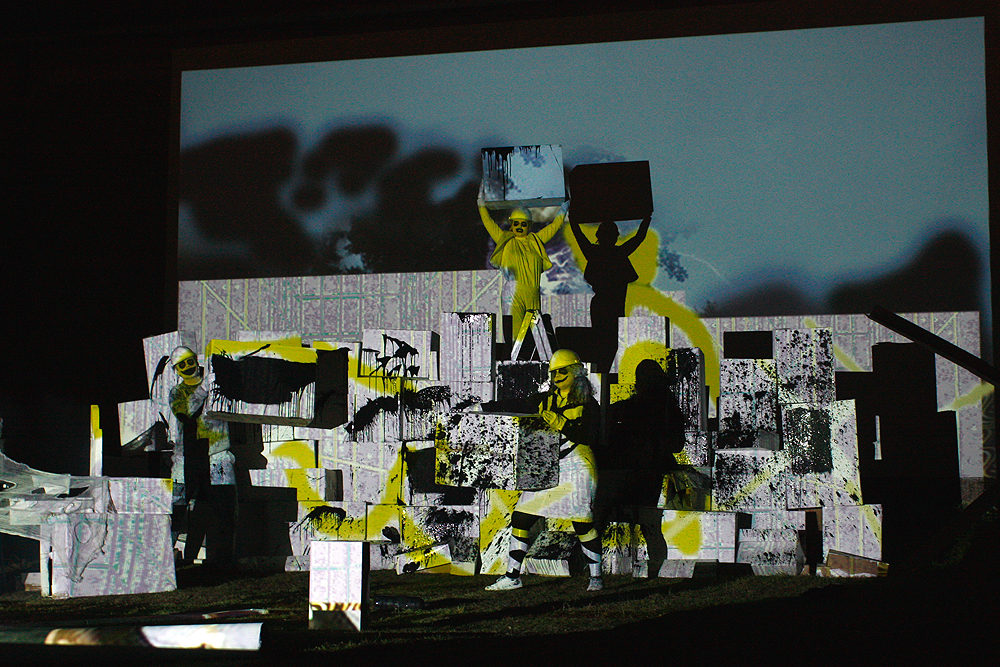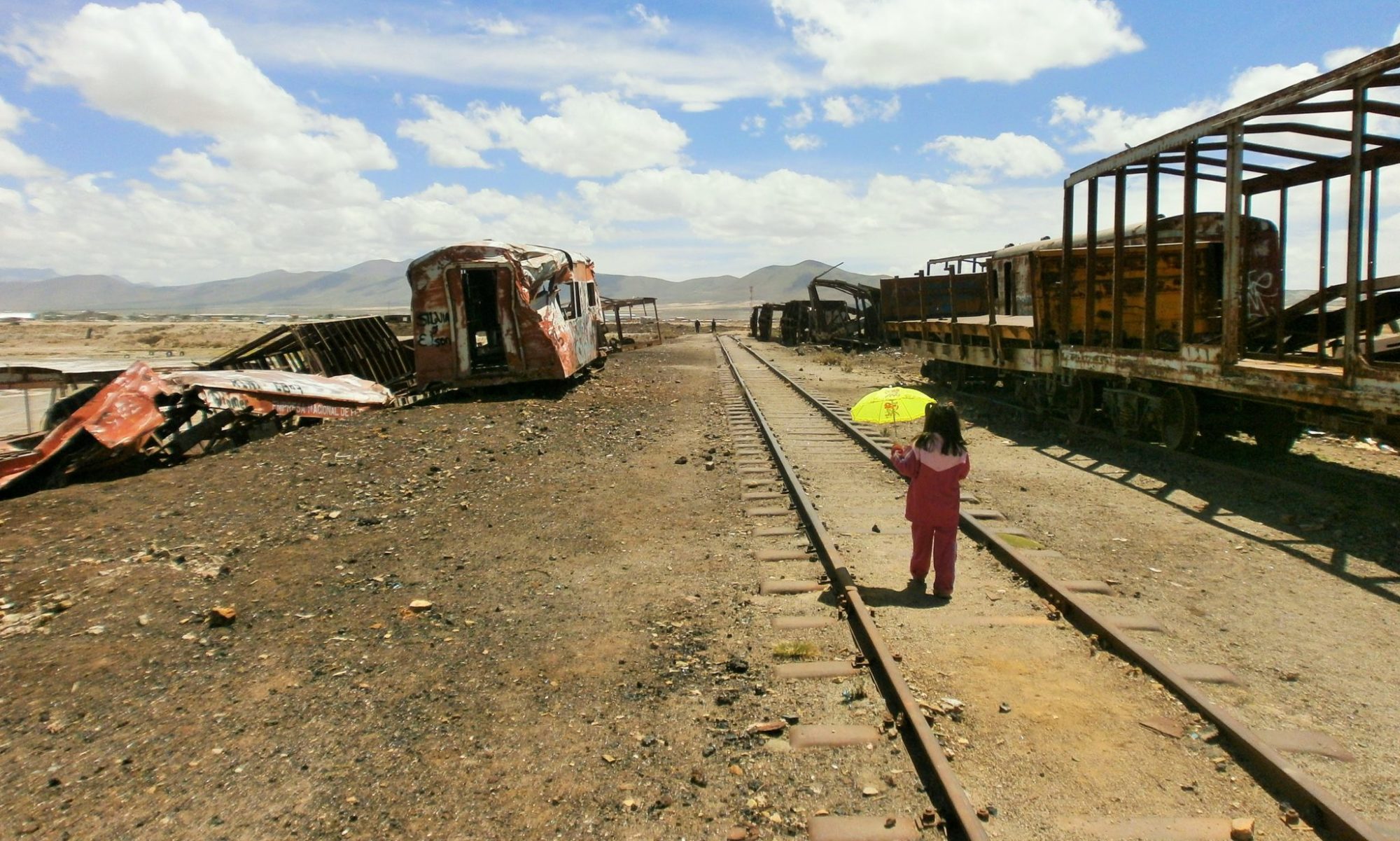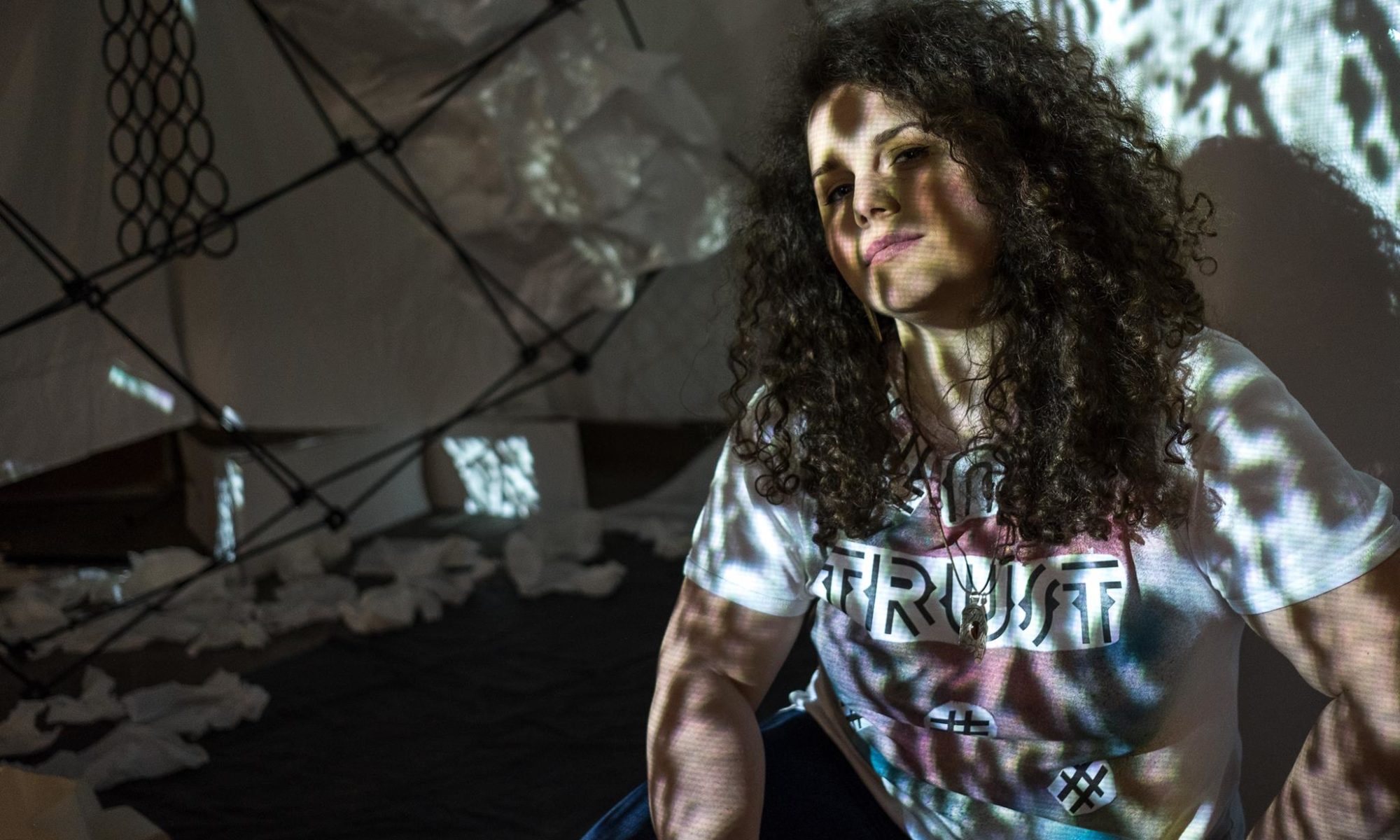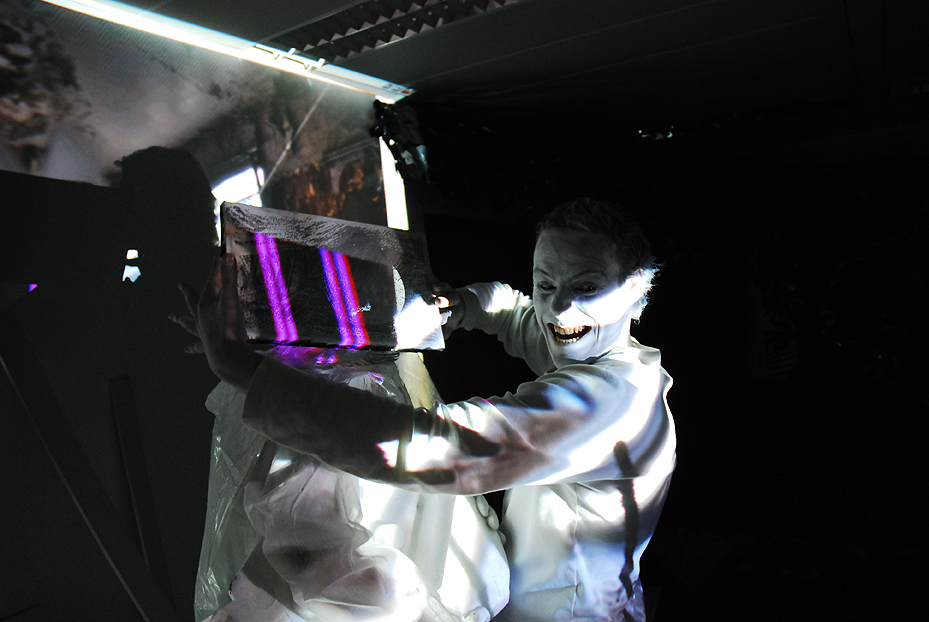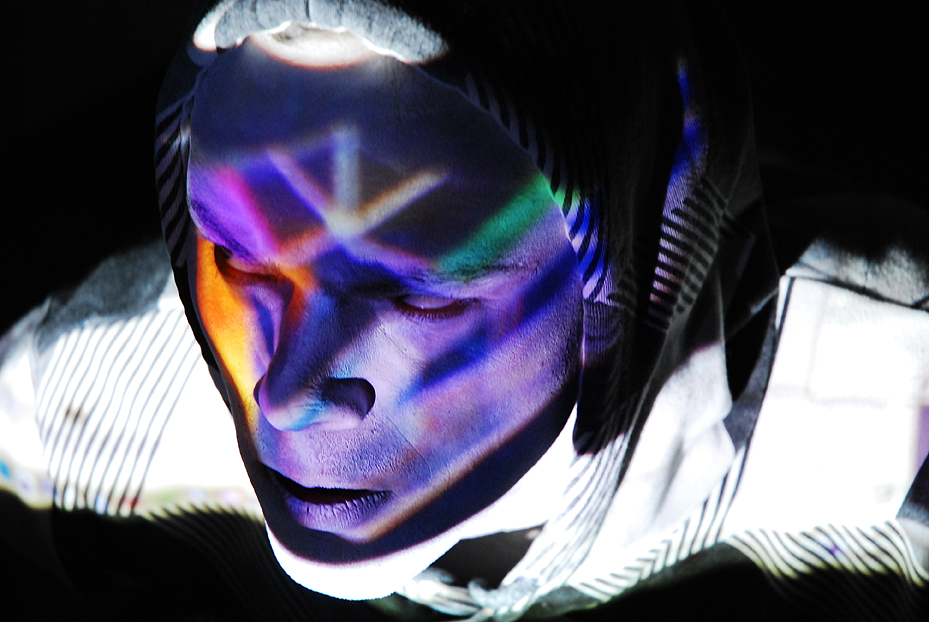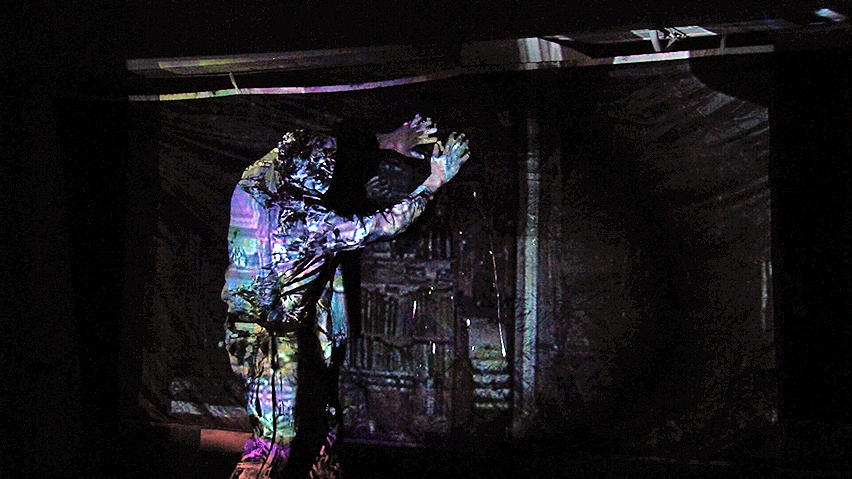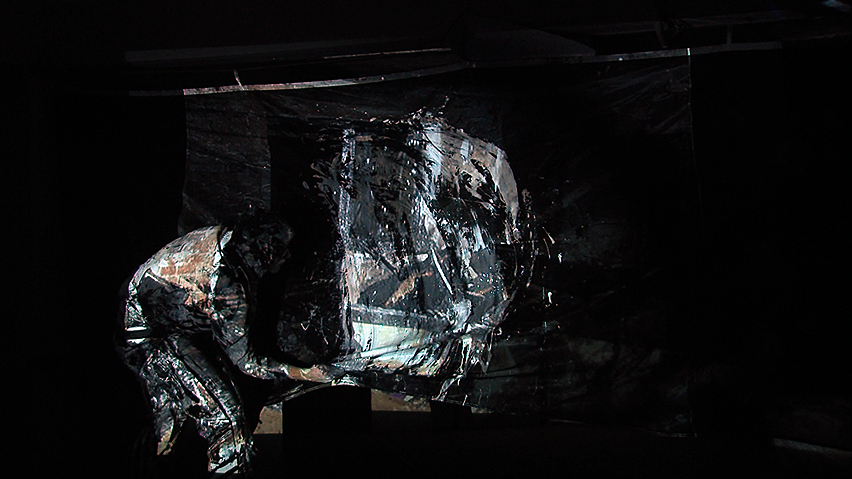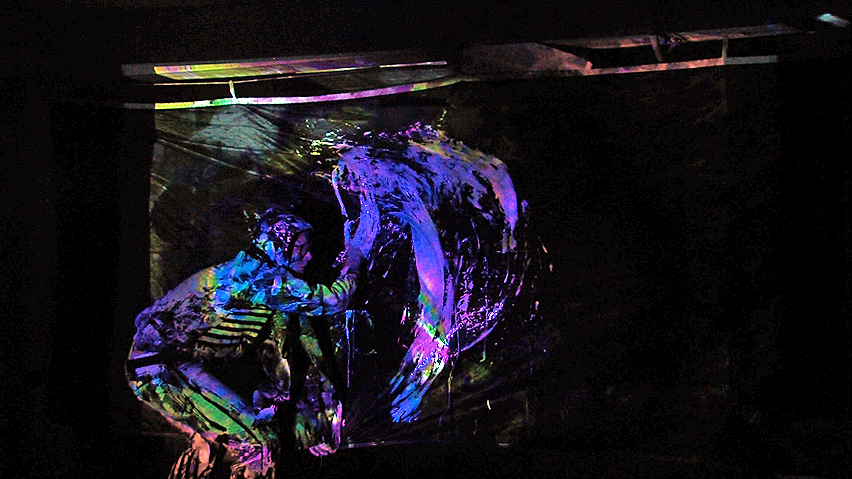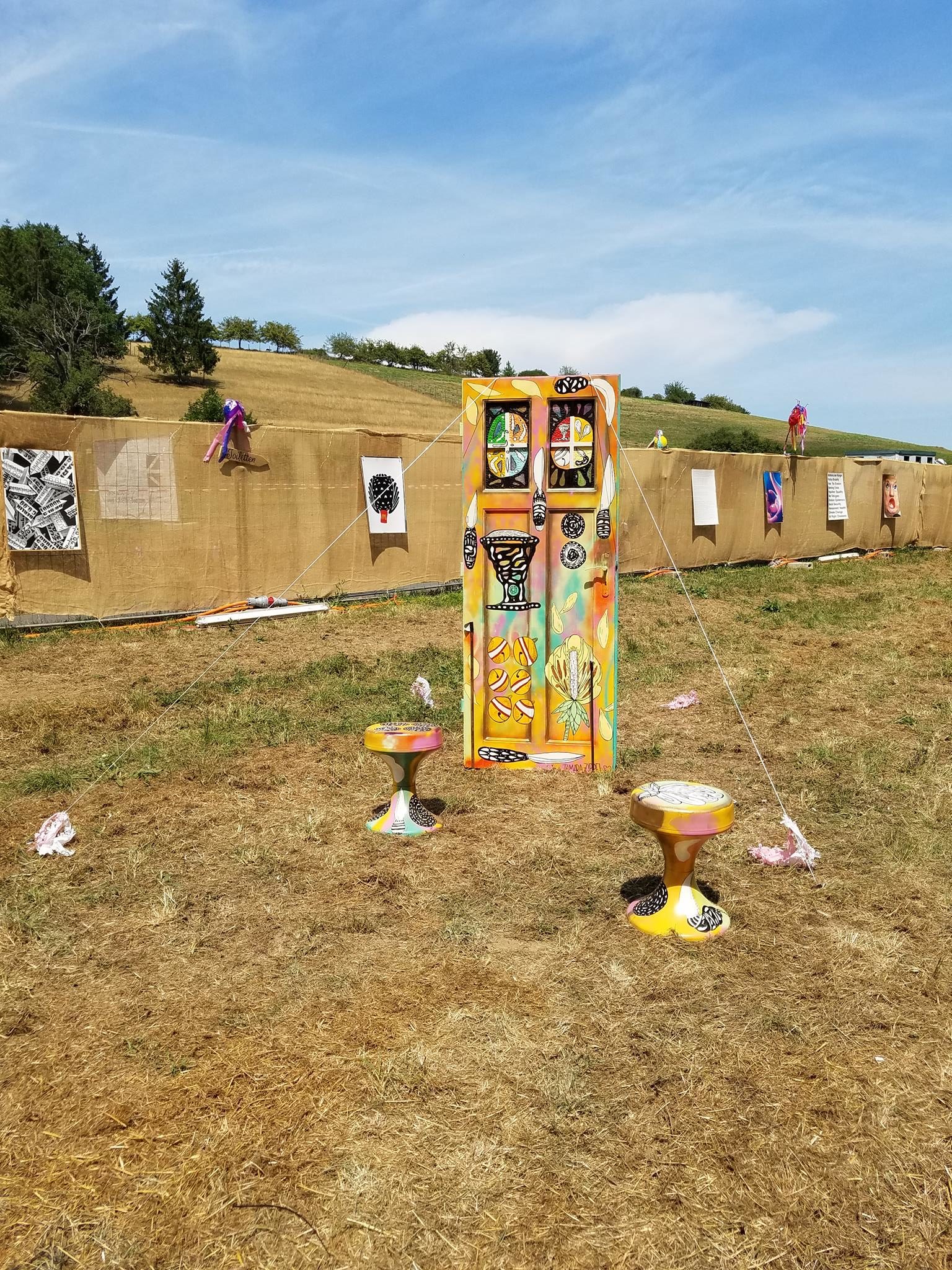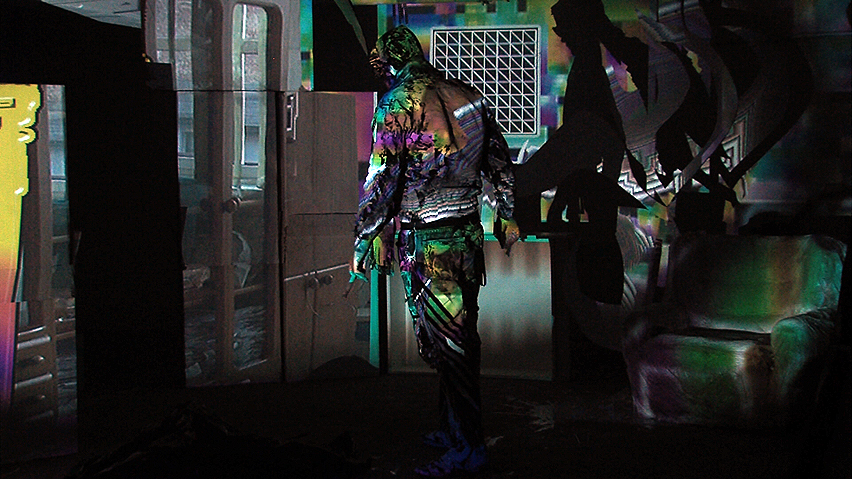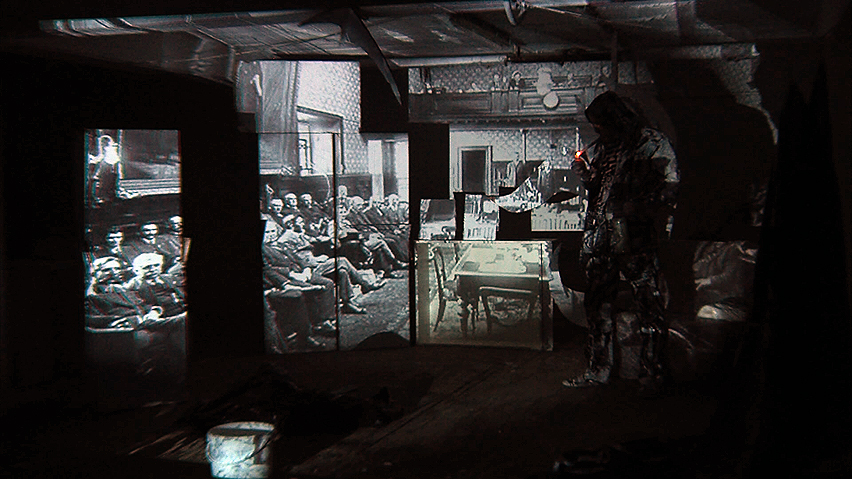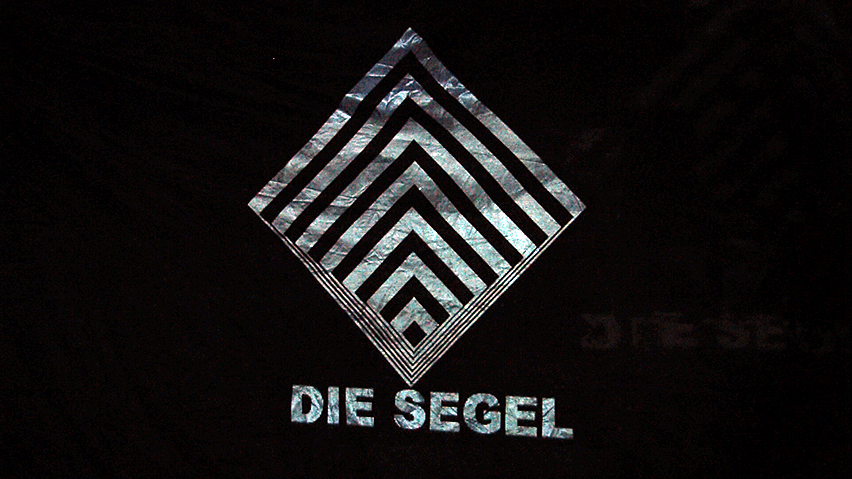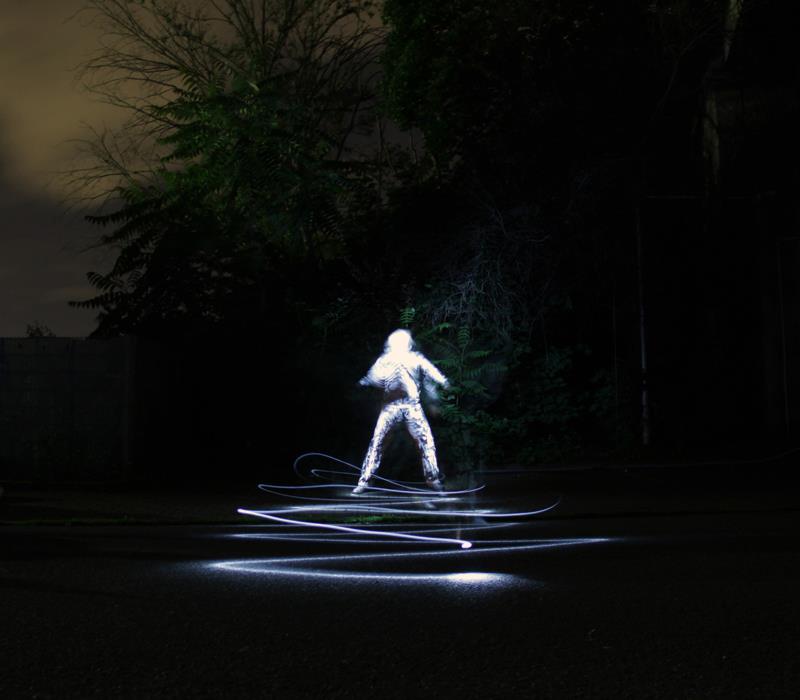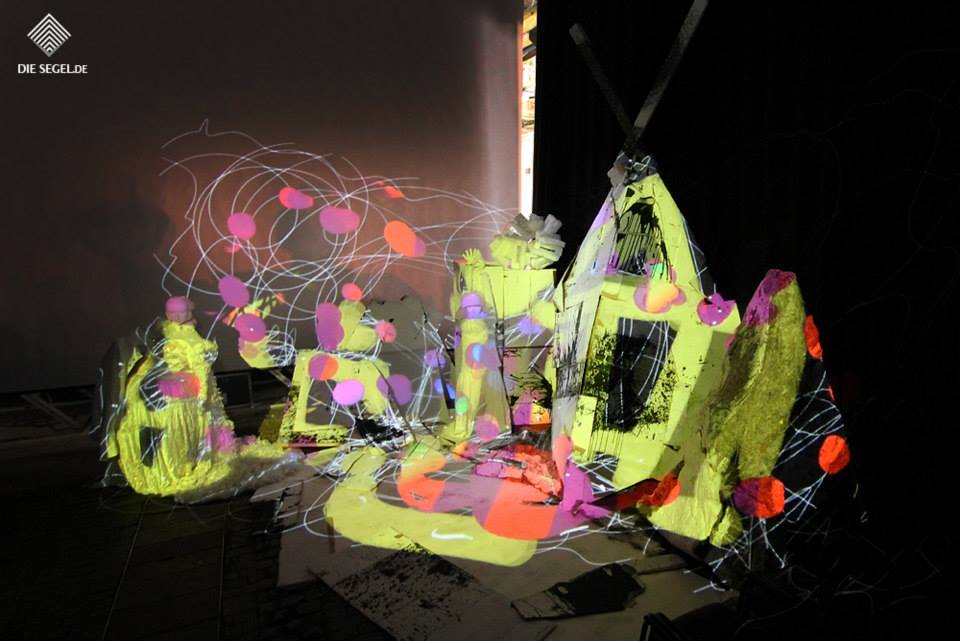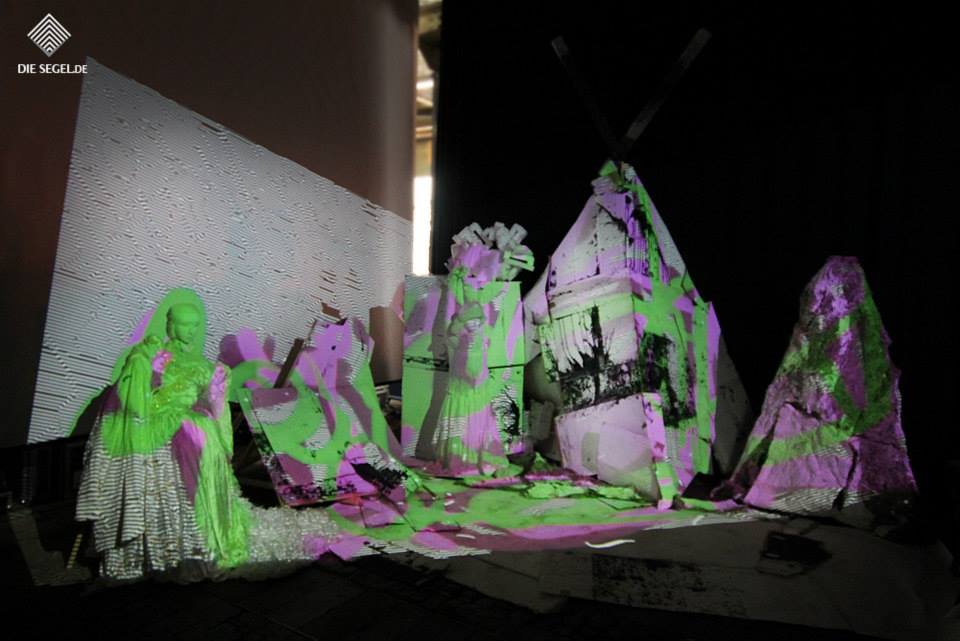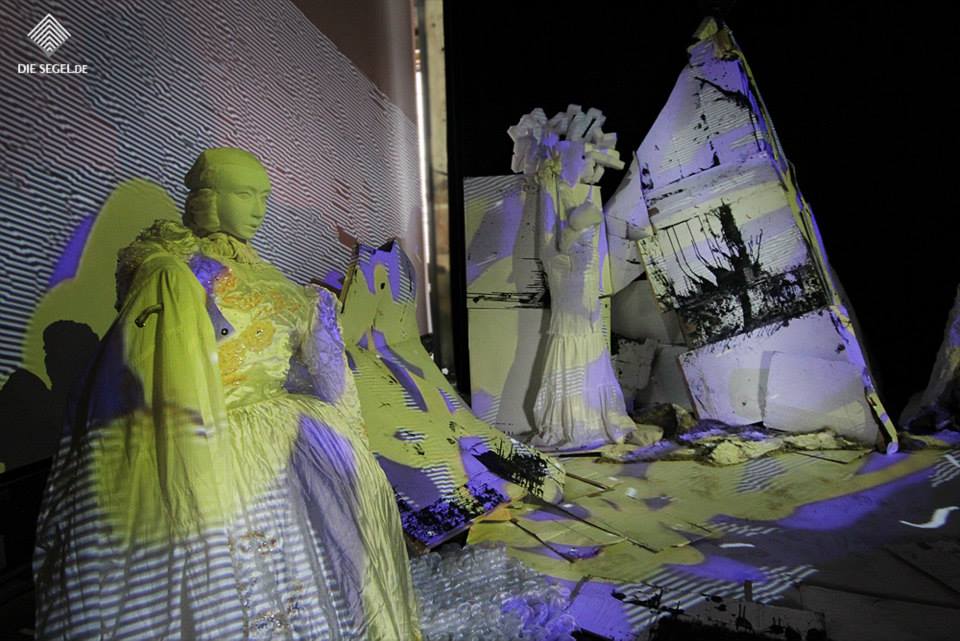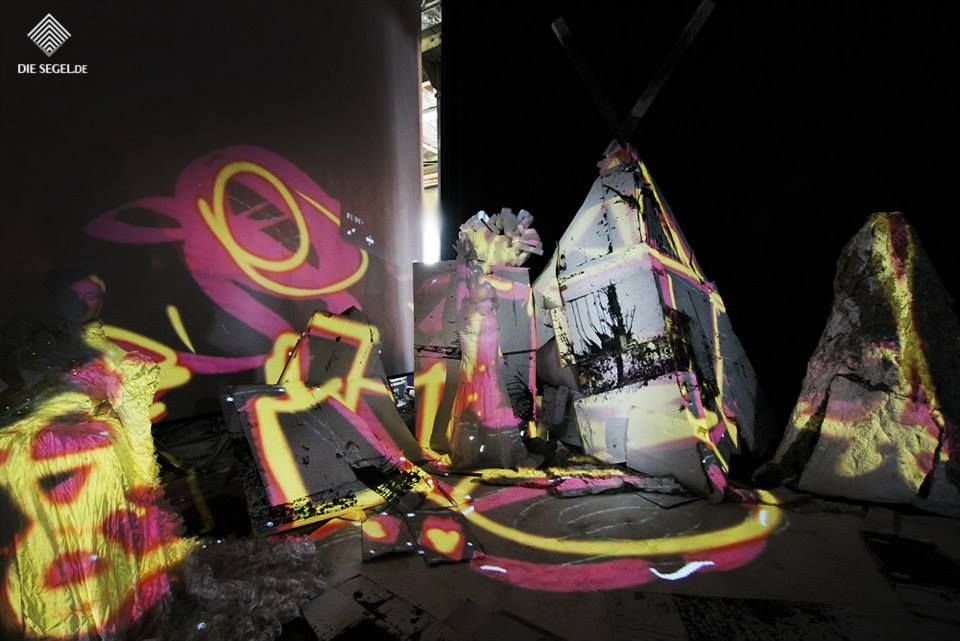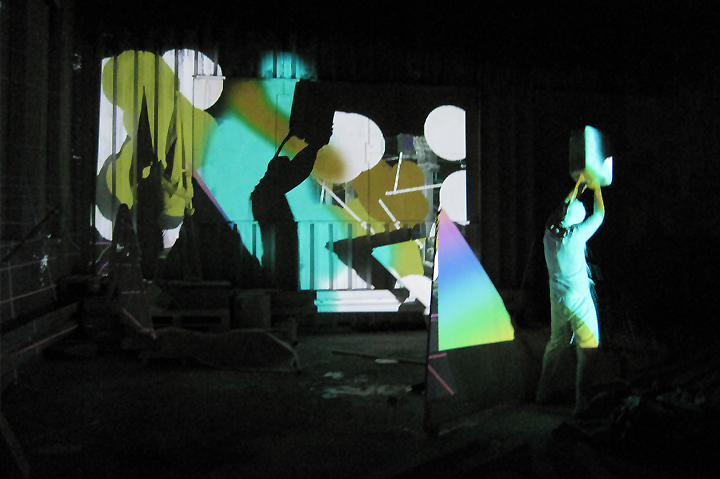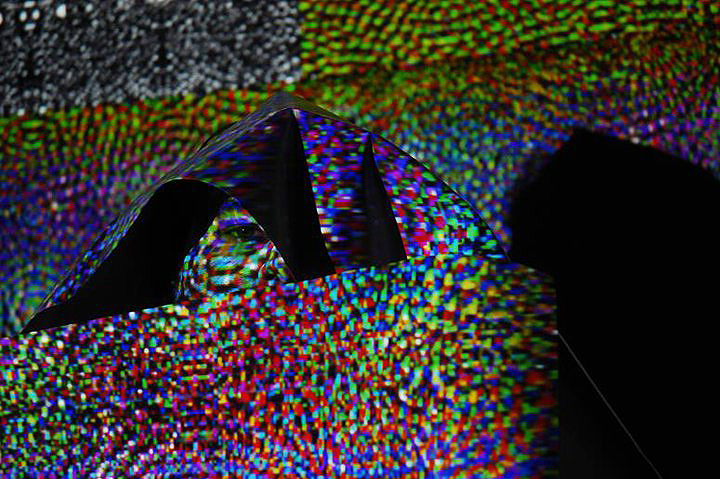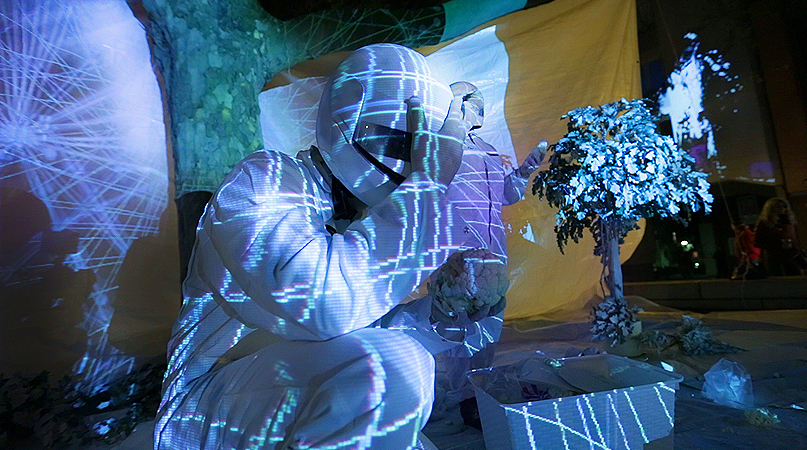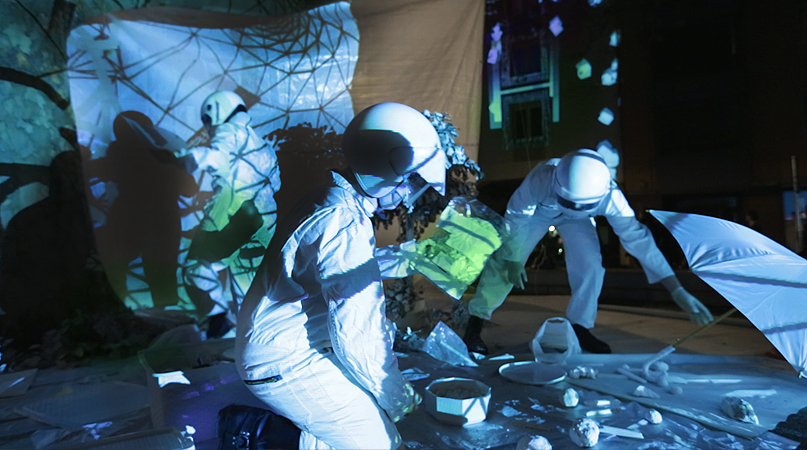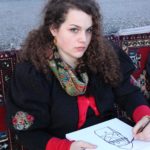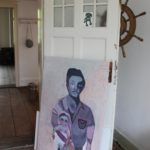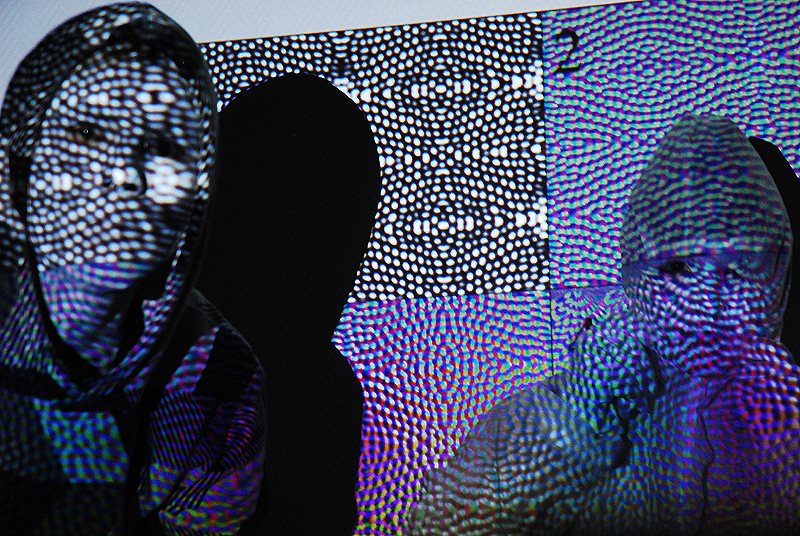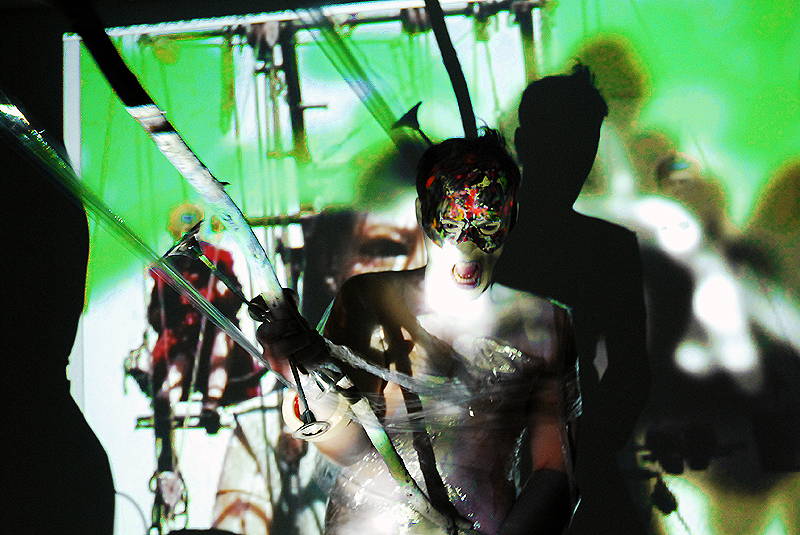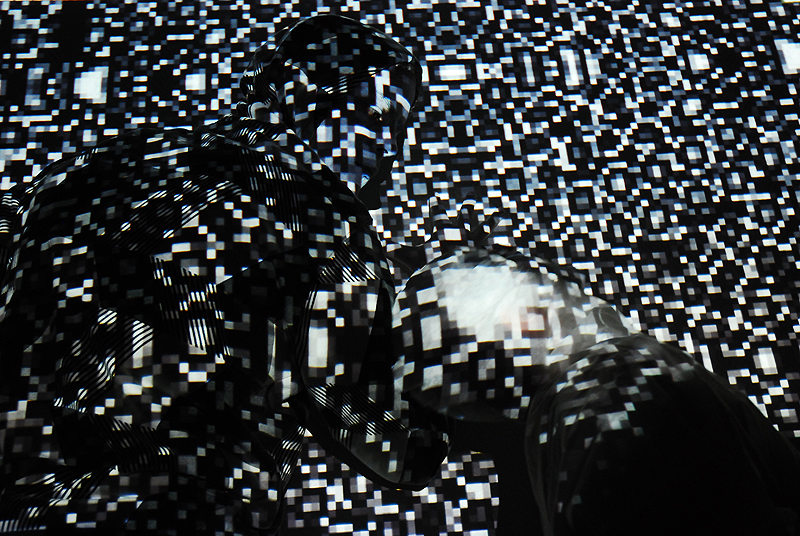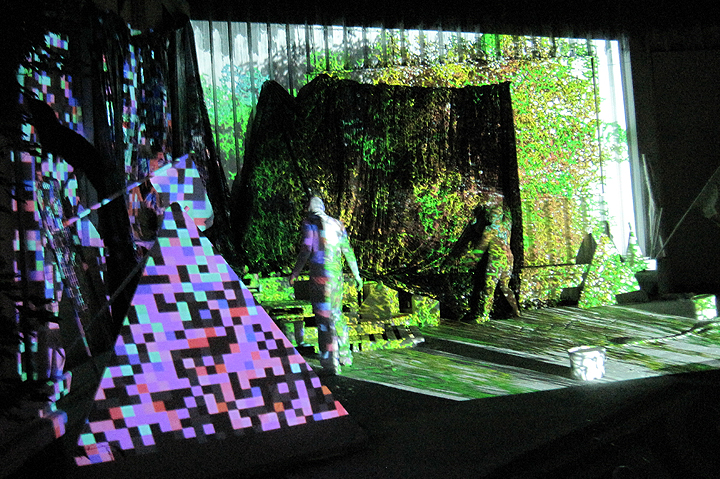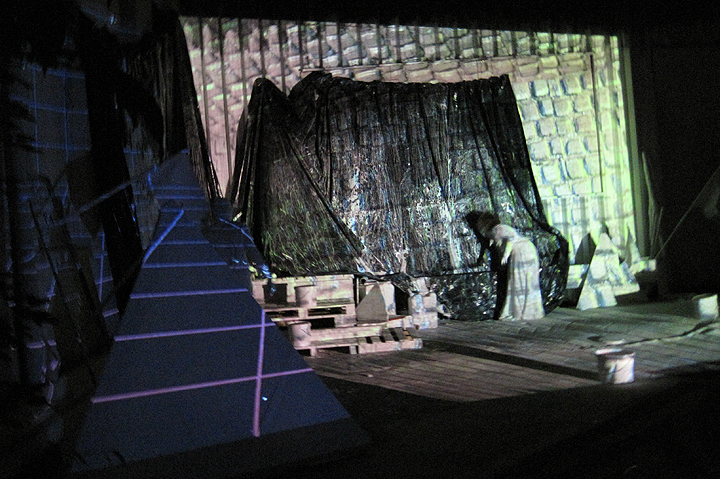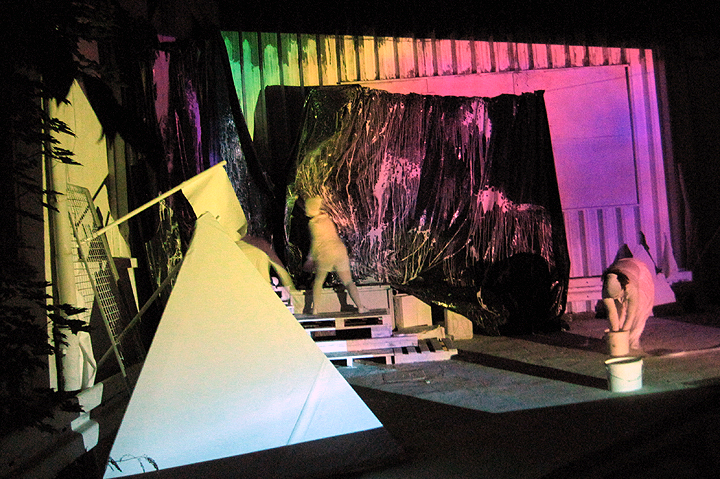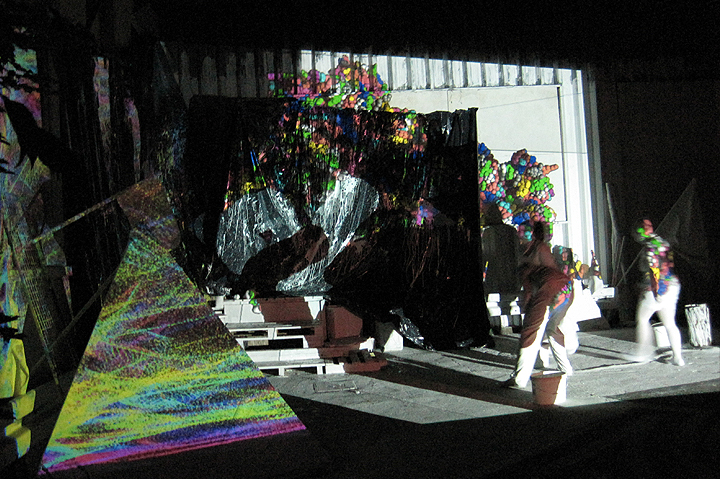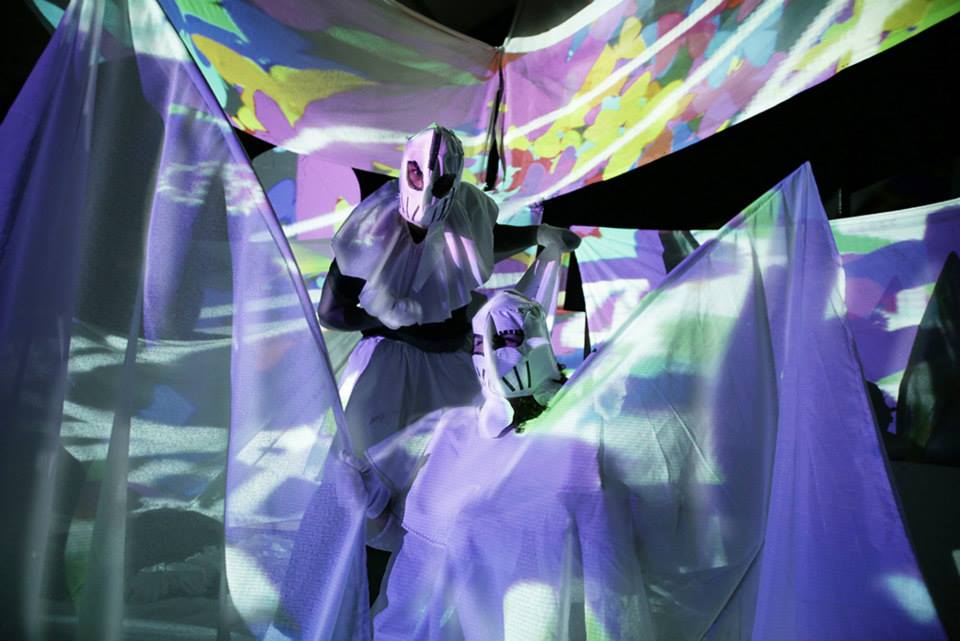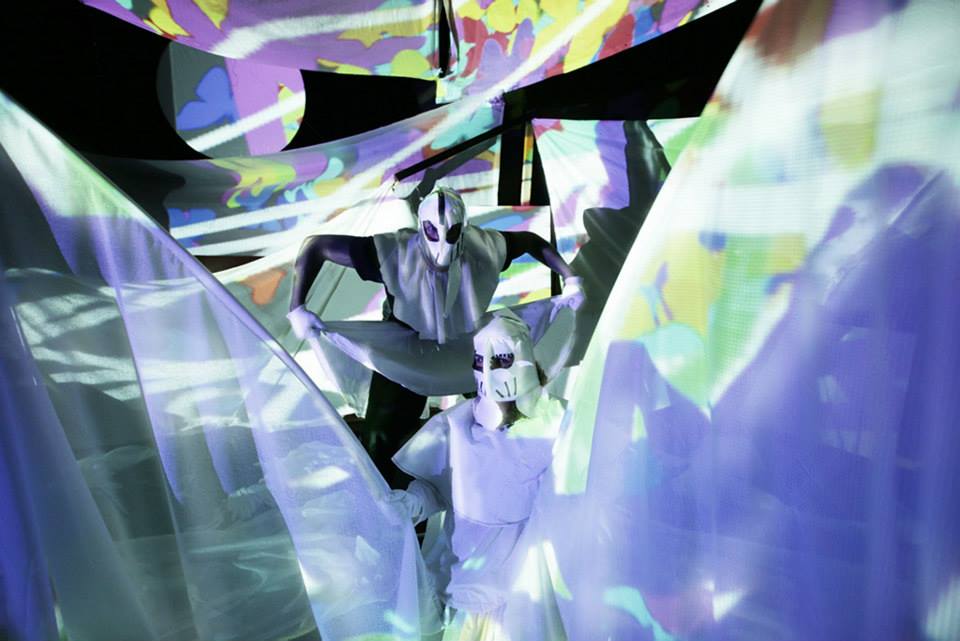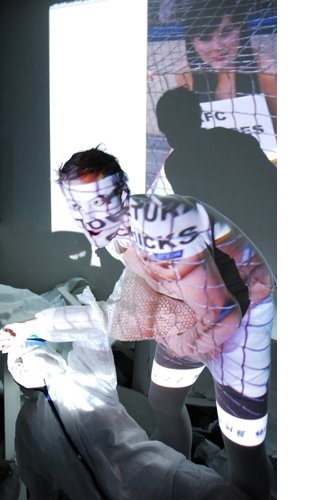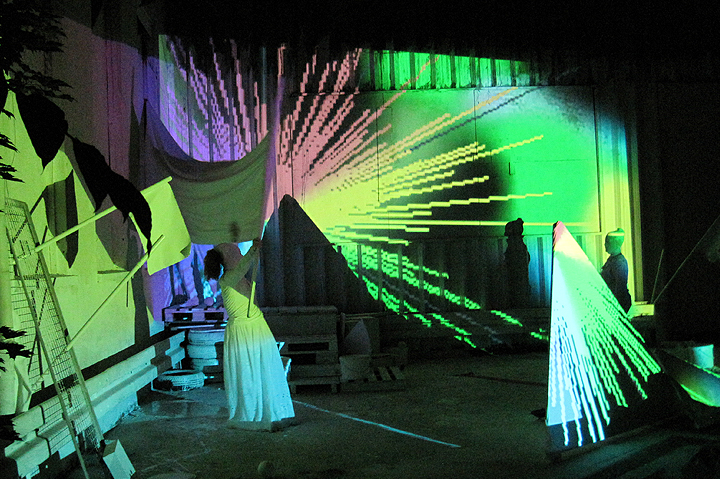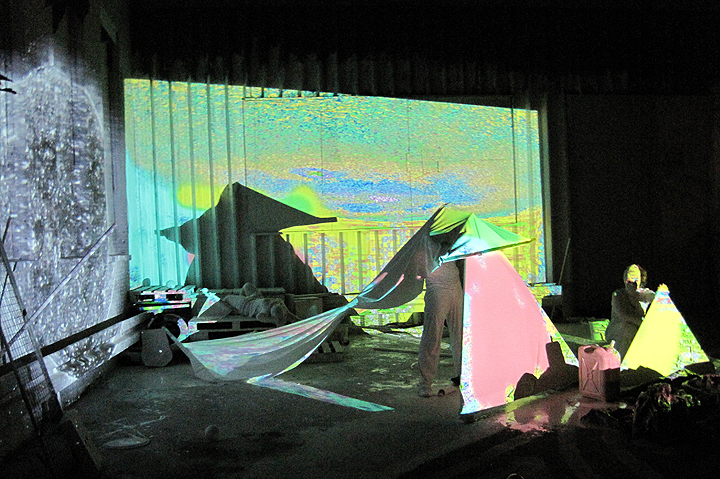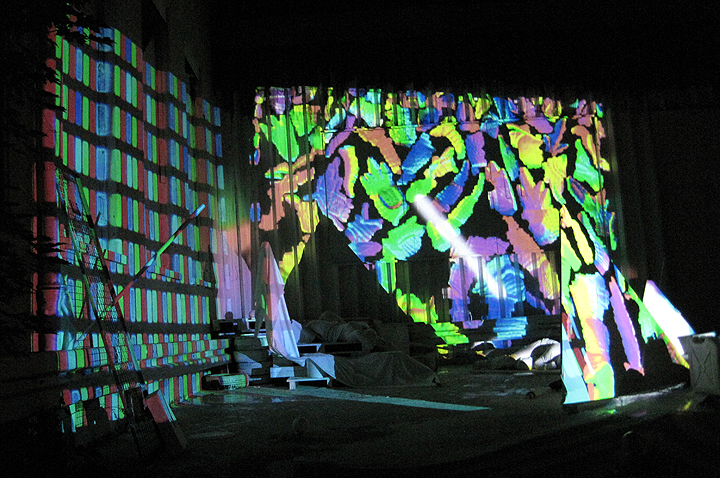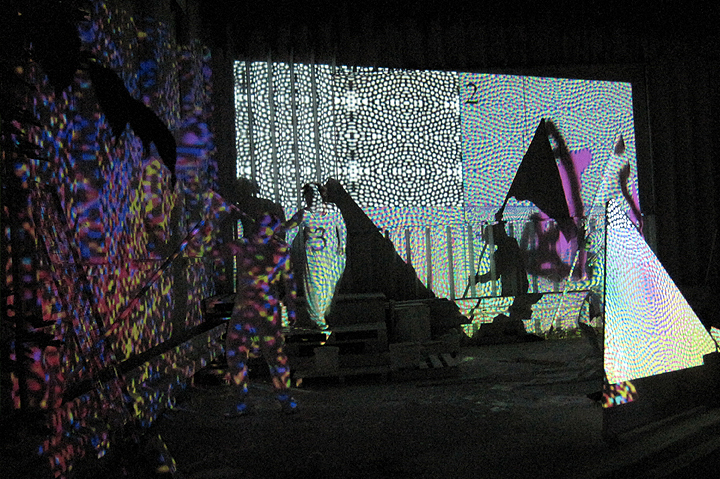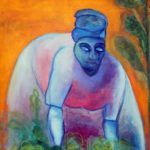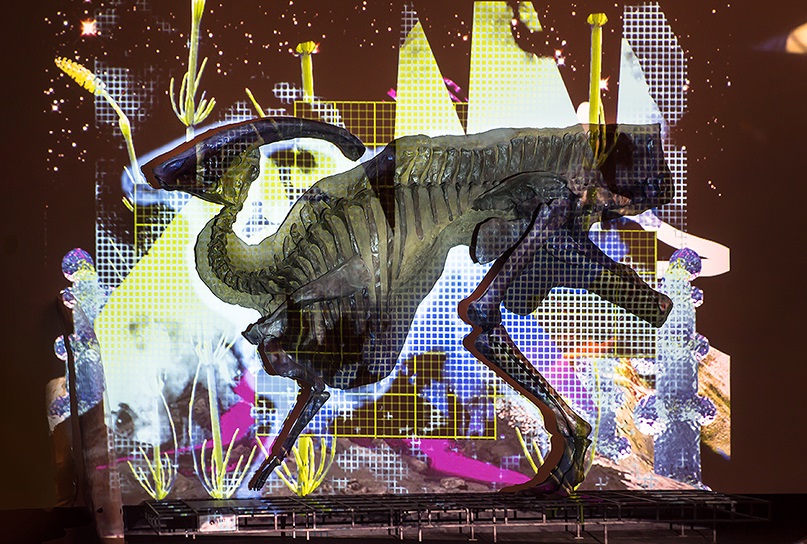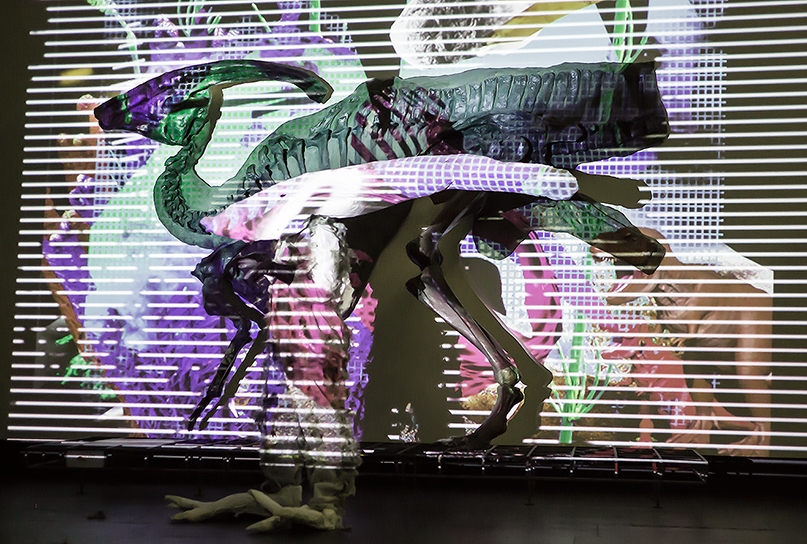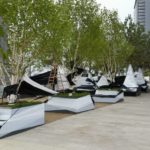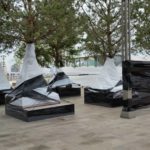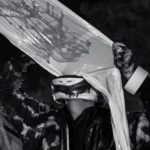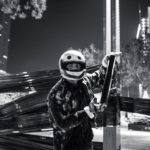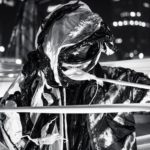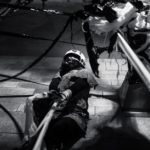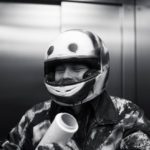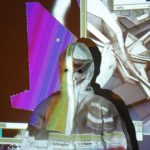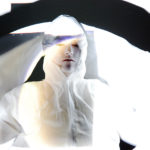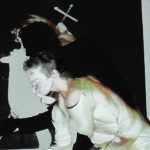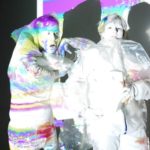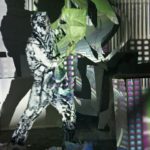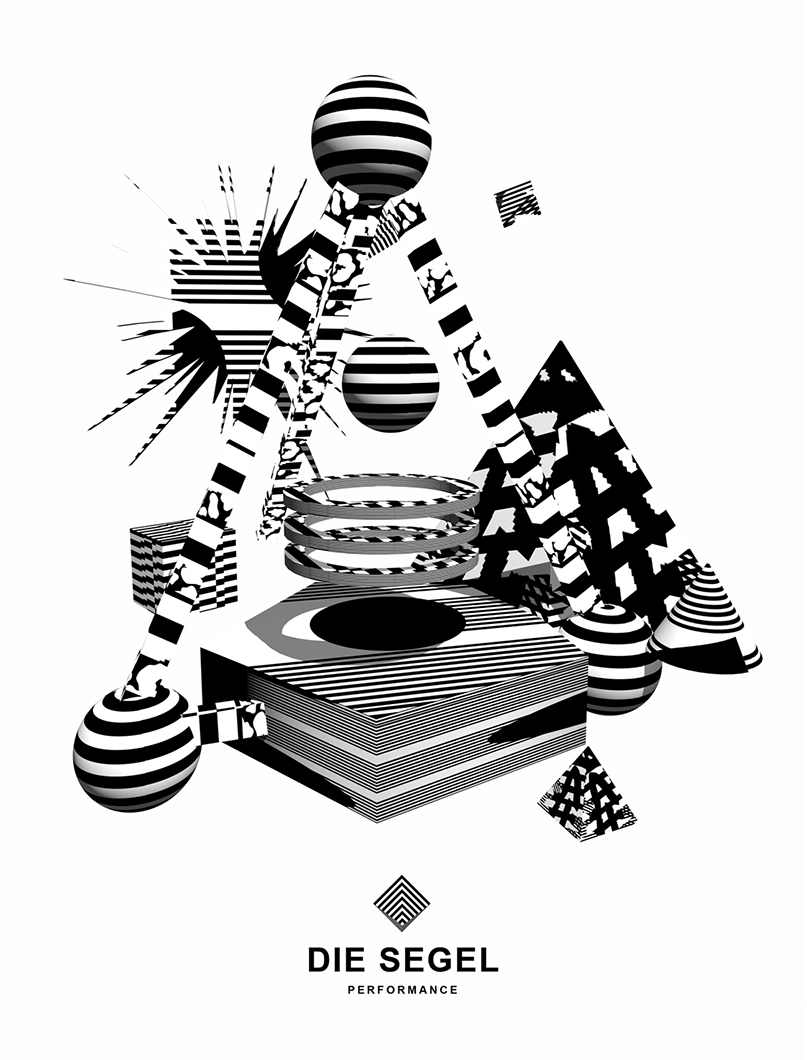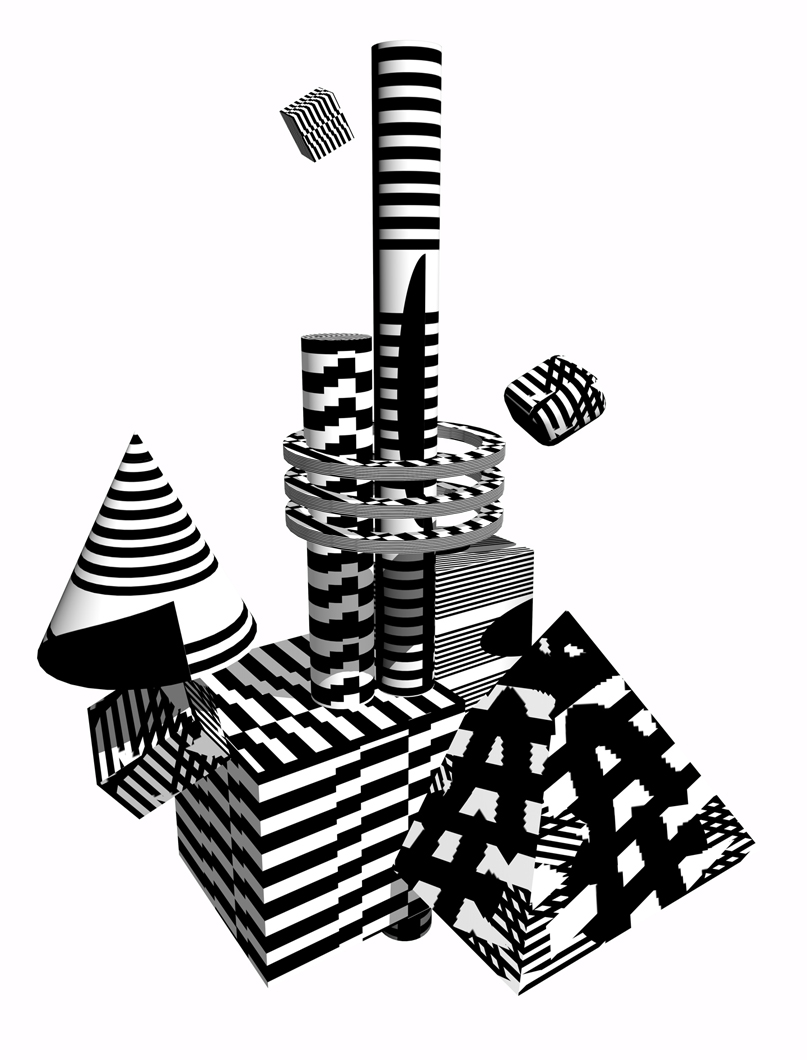Walking cyborg creatures, pixeled astronauts or simply diagonally painted bodies – the wacky performances of the artist collective “Die Segel“ from Frankfurt are breathtaking productions that captivate visitors in a flood of impressions. The costumes are elaborately selfmade and seem to come from another world, self-composed music plays on the stage and the performers are illuminated with self-produced projections during their performance. It is about breaking down boundaries and playing with images and shadows. Emotional perception also plays an important role, feeling and sensing, connecting the senses and above all, stimulating reflection.
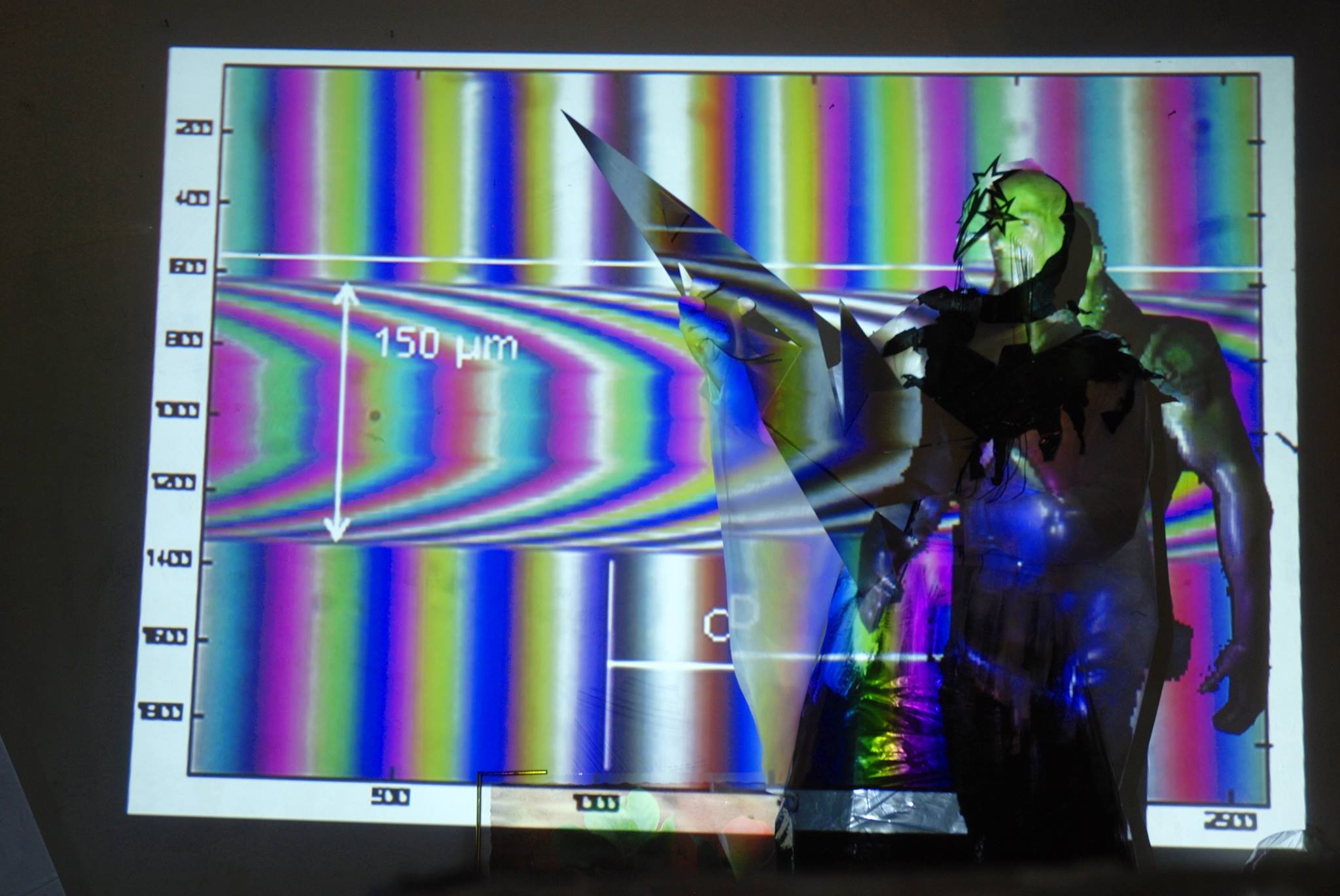
Die Segel consist of Dirk Baumanns, Daniel Eyrich, Lisa Klinger, Erik Pfeiffer, Maximilian Reimann, Sven Schuppar and Tamara Zippel. Originally the artists come from a painting class at the Hochschule für Gestaltung (Academy of Arts) in Offenbach, but from an initially unique performance accompanying one of their exhibitions, a permanent show group has since developed. Die Segel are 10 years old this year! Congratulations on your anniversary! Countless exciting, thrilling, interesting and also disturbing projects have been presented on stages and outdoors, in galleries or at festivals during this time.
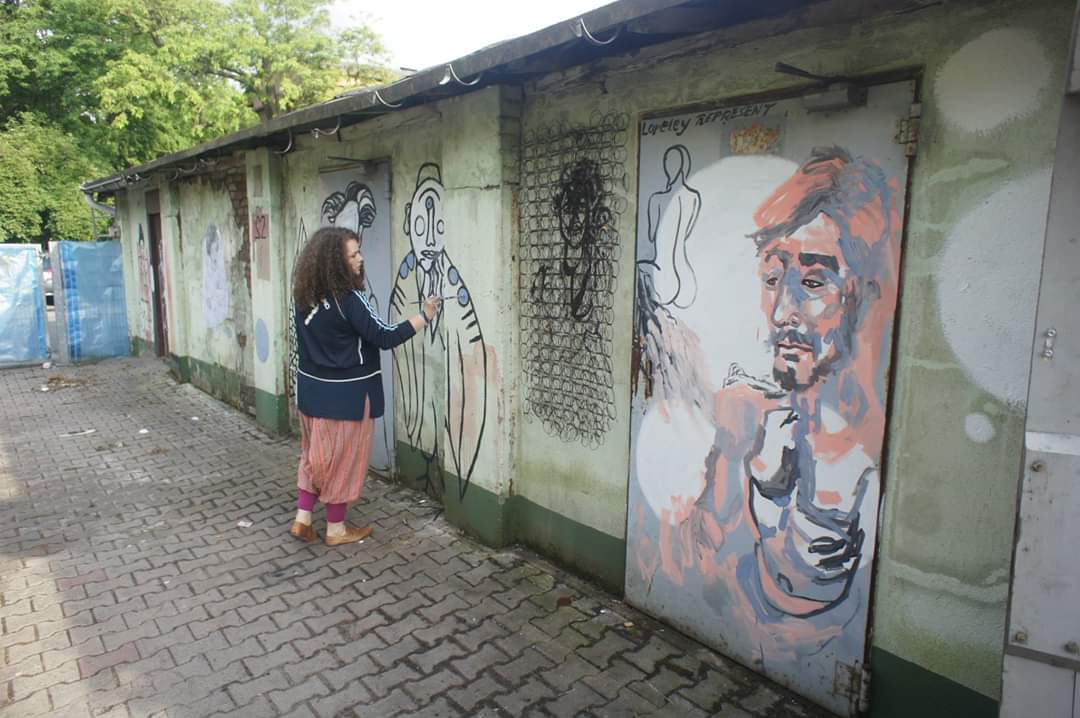
In an interview, artist and Die Segel member Tamara Zippel tells us about her sculptural and painted works, the “Painting Talk Groups” for the KunstGesellschaft (Art Society), the youth work at Break14 and offers a deep insight into the performance world of Die Segel. The interview is available as a podcast in German; the conversation is as well written and translated into English in the following.
You studied art and performance at the HfG Offenbach, you paint and are also a member of the collective „Die Segel“. We will talk about your creative world today and a funny little thing is that you have an opening right now where you actually should be. But the good artists always come a little bit later.
So today, together with many other artists, performers, painters and draughtsmen, there is an exhibition in Offenbach at the Afip. There are paintings, drawings and sculptures of mine to be seen, so also spray things from found objects from the street.

So upcycling? Art made out of garbage, or things that others throw away?
Yeah, I’d love to do that. When I walk past something and it speaks to me, I often can’t let it stand. I then take it with me and sometimes spray it or write stories on it. At the exhibition tonight there are also concerts with many artists who are represented there and also perform.
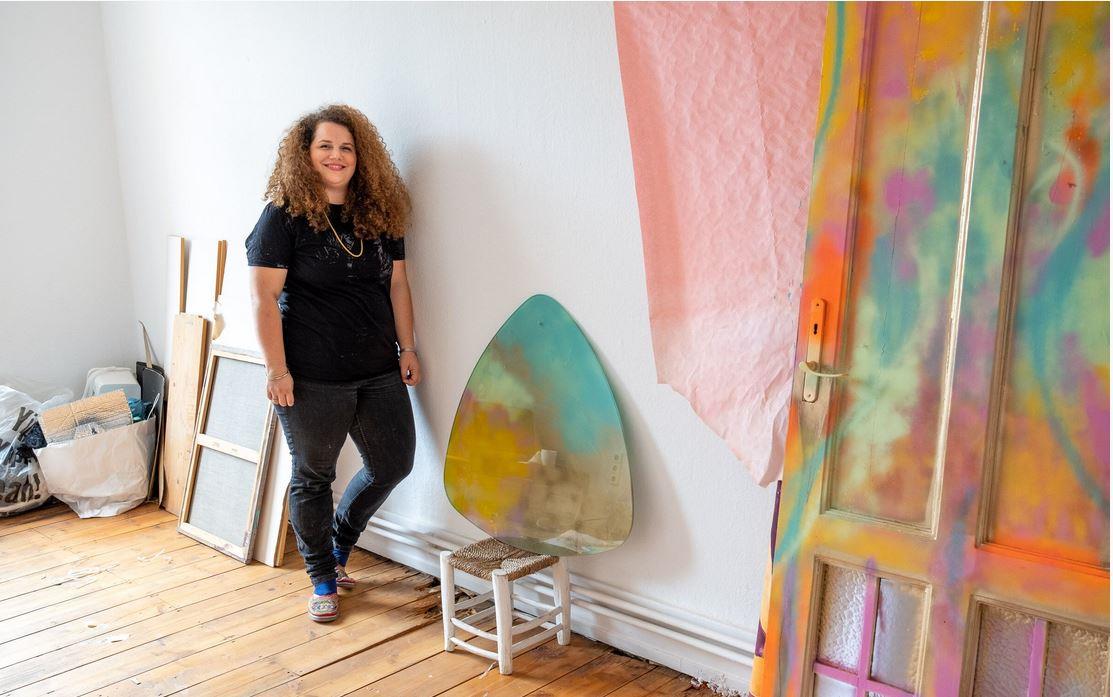
So you are an artist, you do visual art, you also work a lot with children. But you are not only active as an individual artist, you are also involved in various networks and associations and one of your main groups is “Die Segel“. What are “Die Segel“? Tell us about it.
Yeah, so “Die Segel“ was created many years ago. We have all been friends for much longer and got to know each other while studying at the Hochschule für Gestaltung in Offenbach. At that time we had a studio community in the Diamond Exchange at the Konstalberwache. That was temporary and we got a place there. In my studio there was even a small safe. This was a great opportunity. We were all on the same floor and worked together a lot. Originally we all come from the painting class, that is, from painting. And we had an exhibition together there, the COOP. We wanted to show that we are not all the lonely painters, but that we can also do something together. Actually, that was a one-time thing. We had thought about that before. And yes, that has been the case to this day. This year, i. e. 2020, it is now 10 years. So it’s an artists‘; collective. Daniel Eyrich, who also originally comes from a painting background, always makes the music during the live performances. The music is very important for our work and is also a supporting factor. We have always worked with his music. This is often also the beginning of many things. We react to his music and also through movement. And Erik Pfeiffer, he takes the pictures and they are projected onto us. So we work a lot with projection and with light. Erik then also reacts to the music.
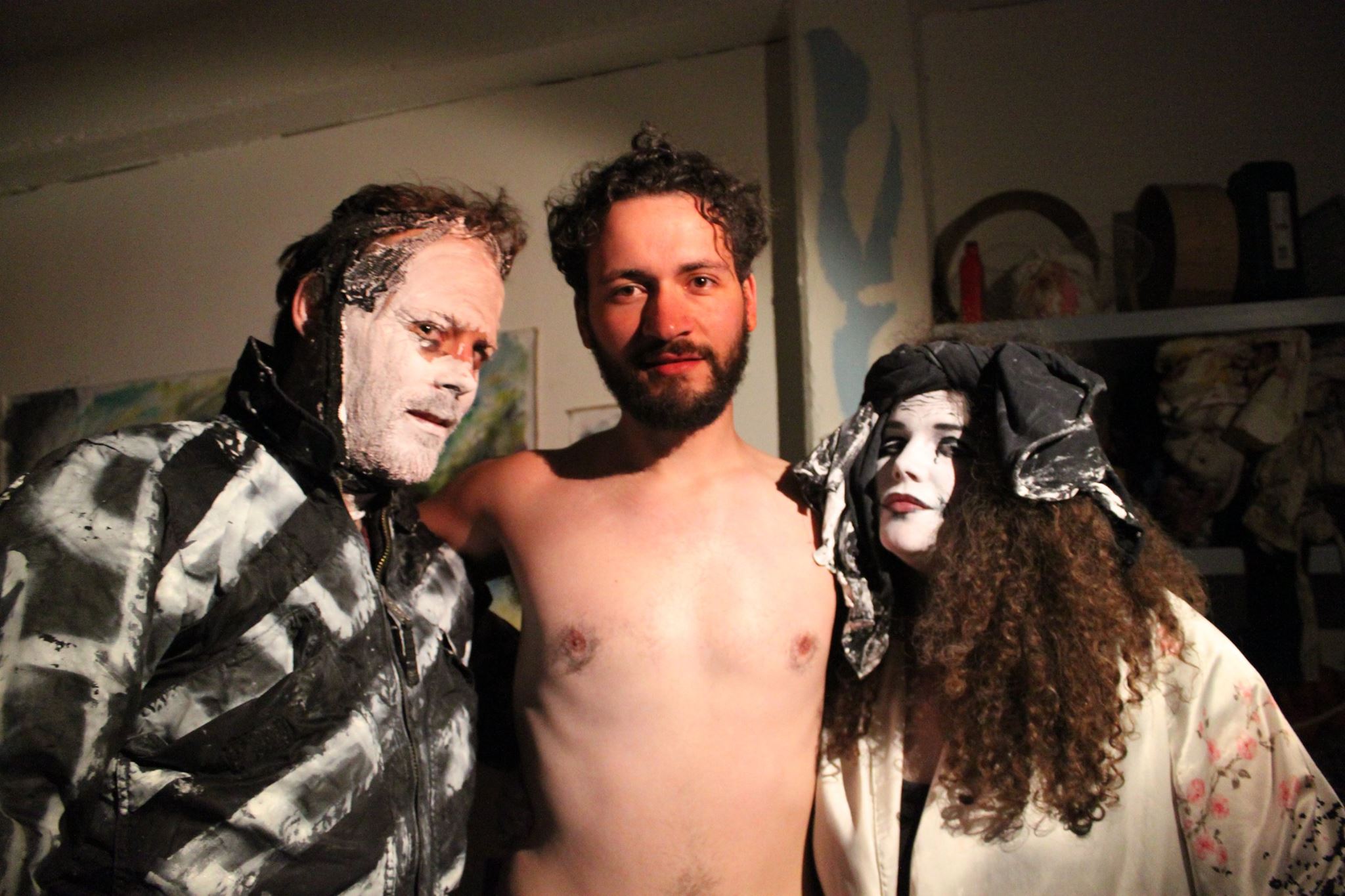
It’s not just a matter of meaning. Instead you try to touch several senses at the same time. So while you’re looking at something, the visual, you get to hear something. And these are the effects you give to the visitors. That is your intention and how it all works together in the viewer. So place plus picture plus sound plus everything, just this mix.
Yeah, right. Sometimes it even smells. But of course it’s not theatre, it’s performance. I never studied acting and I don’t even know how to act in that sense. But when we stand on stage, we don’t see what is projected onto us. Usually, the stage and the pictures are agreed upon beforehand, but we don’t see this and sometimes we have such elaborate costumes that also restrict our movement or even wear masks through which we can’t see at all. It is then actually the case that one must feel the other. In other words, the other performance artist, because there are usually always two of us. In our early days, Lisa Klinger was still with us, so there was a third performance artist, who is also a painter. And then of course you had to feel, where is the other one and what is the other one doing? And you always have to listen. The music of Daniel is always the signal for us. So what’s the mood? Is it quieter now? Of course this also influences our movement. The music permeates us too. We once did a job for the Luminale. Diamantra was the name. We really performed for hours. Nonstop and without a break. And we were trying out. That was also simply an experience for us. How long does the audience stay? How long can they last? Are they staying as a courtesy or are they leaving? How long can you even keep this up? And the music was always there, for hours. As an artist, of course, you internalize this much more intensively and in the performance.
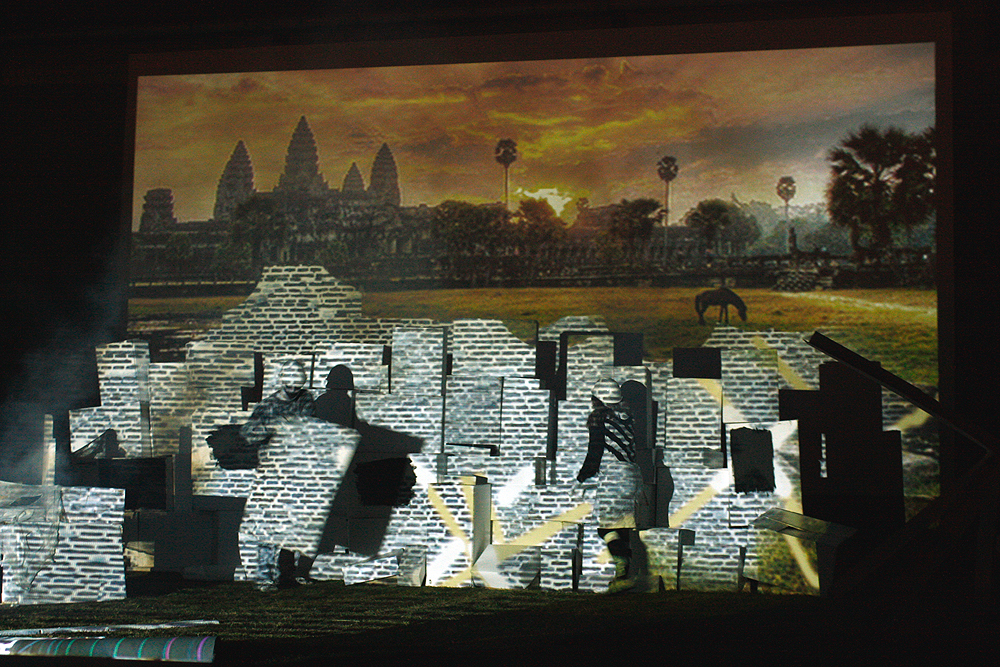
Most people tend to separate more categorically into art genres, such as painting, sound or sculpture. But you want to express that one thing flows into another. You can draw pictures, but you can also become an image yourself in a smooth transition. The performance is a complete process. It starts with a picture hanging on the wall and you yourself then, figuratively speaking, step out of the pictures and become art objects yourself.
Yeah, and we don’t talk. This was a conscious decision from the beginning. Also that I will not undress as a woman. This is not unusual in performance. So Marina Abramovi? did it to the limit, if you know her work. Yoko Ono, too. It is not uncommon in the art world now to make the female body a theme in art. But for us or for me there was always the decision that I didn’t want to do it. Not because I have a problem with my body now, but because that is not the issue now. But that it is really about creating new images.
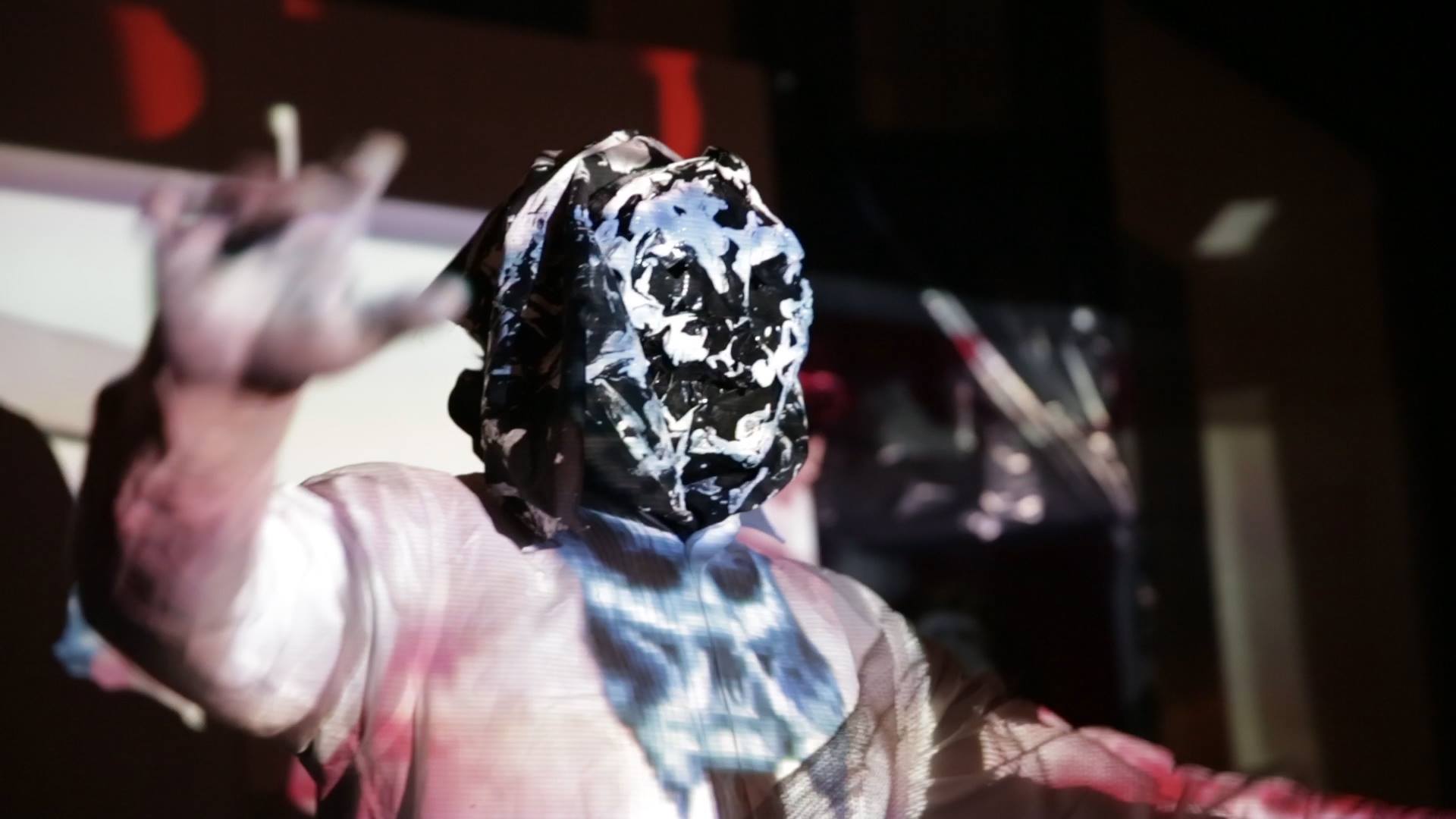
It is also about how you and each of you want to show the performance. And not what is fashionable or artistically popular right now. It’s your way of expressing yourself.
Yes, and also because I don’t want to repeat Performance is not theatre. And if you deal with performance, Dirk and I both studied performance with Mariola Brillowska. And when you look at it, you see that there have simply been so many strong women who have done this work to the limit. If I were to do it again now, it would always be a lame copy, or maybe I didn’t care that much about doing it yet. But on the subject of language, it was definitely a conscious decision not to speak. Our language is Daniel’s music, the pictures and also the flowing transitions. So like you said before, there are really smooth transitions and especially because we work with projection and our costumes are always black or white. There are no colours for the costumes. It only looks like that because of the projection. But our costumes are always black or white. And we always make them ourselves. For every performance there is usually always a new costume. Depending on what we’re dealing with. And in the black areas, there is no light to be seen. And in the white areas, there you can see the projection. And because the background is usually also black or white, the body is sometimes also mixed with the background. So there’s no real front or back. The body and space sometimes merge into each other.
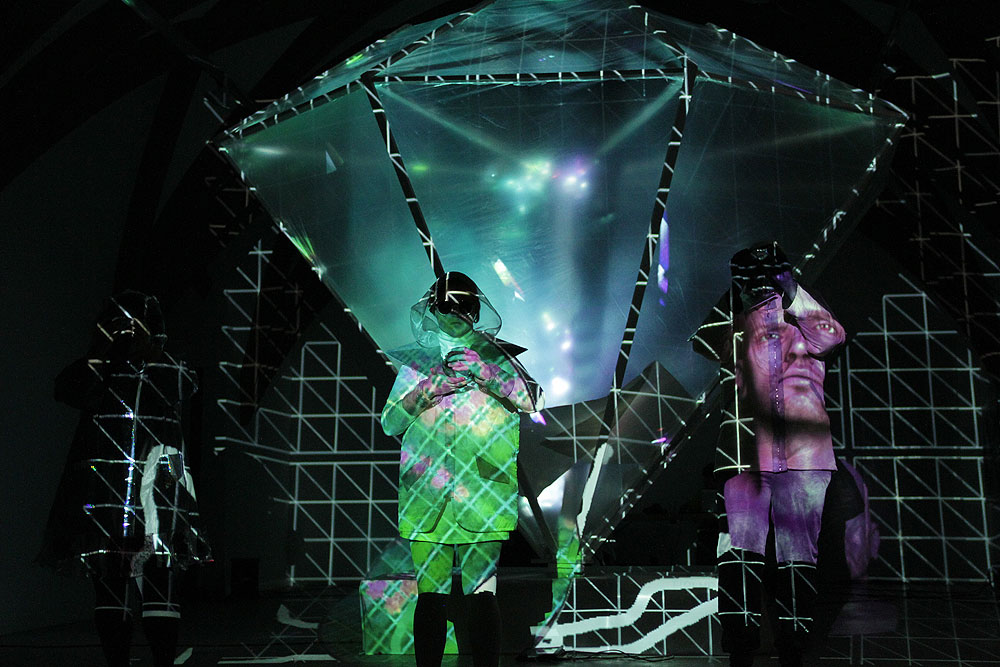
What is the difference between doing theatre and performing?
So, yes, theatre is simply something like Shakespeare. You have a play, there’s a script. Then there are costumes, then there are actors and they play the appropriate role. This is given by the director, depending on how he interprets the piece. You’ll play that part. I never learned how to do that. So to act and portray me in that sense. Performance, as we understand it, is also about being authentic in the here and now. And maybe even slowing down. Maybe performance is a little closer to dance. Or maybe you know it from China or Buddhism, when there are different traditional dances or festivals. Maybe it’s actually a little bit closer. Also that we create our own ritual in that sense. Of course, we ourselves have also dealt with it strongly before. It’s not all spontaneous. We already know what we’re doing. And this is also agreed upon beforehand. We also know how to build the stage. We know the process, we have a theme that we deal with musically and also in movement. The interview is actually interesting for me to describe our work, because I realize that we haven’t talked about our work in this way before. But I think the others would have a similar view anyway.
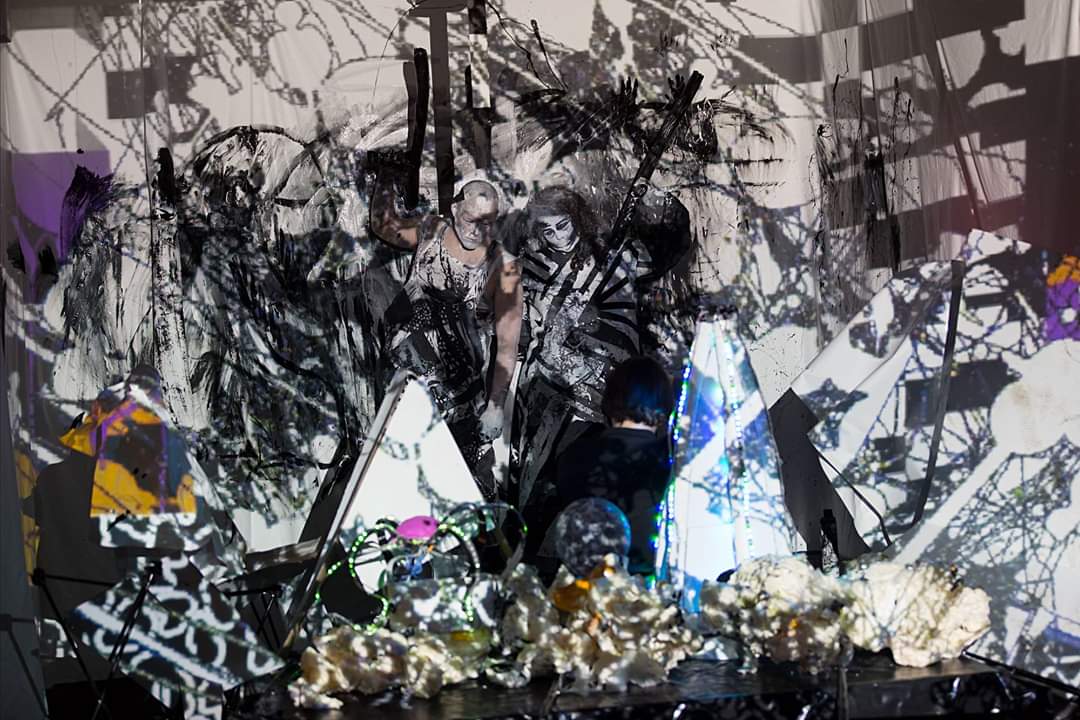
That’s why I think there’s a lot going on at the emotional level. Also how you communicate or how you know what to do. Well, it’s non-verbal. I thought you said there were no lines. You’re not talking. So it is not that you have arranged everything beforehand and then it starts, but that a lot of things are going on on the emotional level right from the start.
I believe that performance making in itself has sharpened my antennae, my sensitivity. Through the performance I also got to know Dirk Baumanns in a completely different way. I now also know his body, so when I now see him moving forward or I see him moving here and there, then I often have a presentiment of what is about to happen. I also think that over time we can and do trust each other in our abilities. But that does not mean that it can’t get hot before it does, or that it can even go bang. Not only immediately before the appearance, but also in terms of content, when it comes to what we do then from the work. In any case, there is always a lot of friction and discussion, but that is also very important.
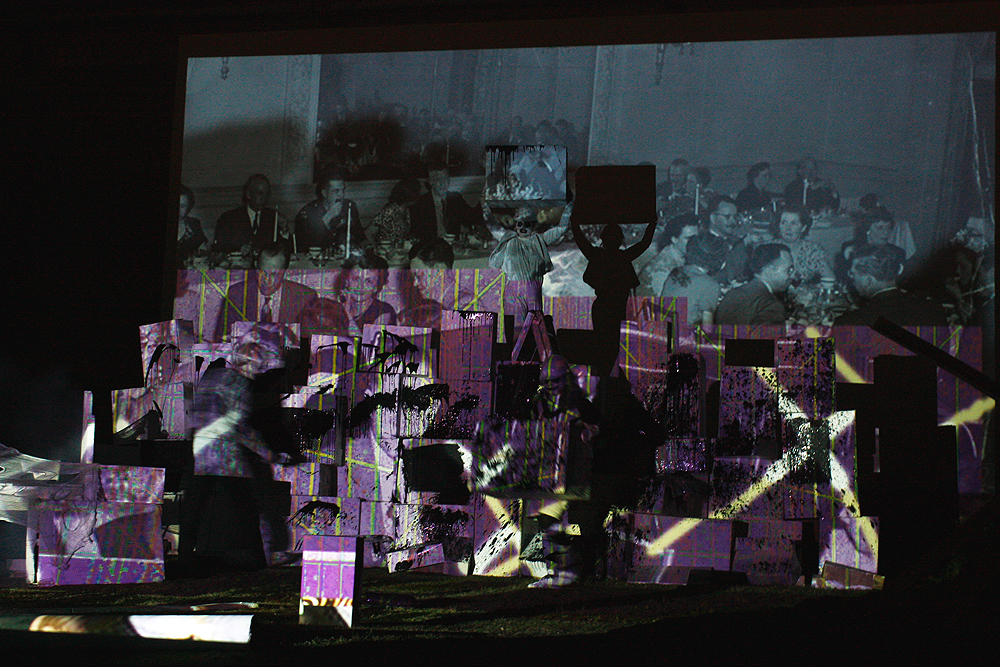
This can be beneficial and you are still together. That is also part of the process of creation.
I also think we are a bit uncompromising in the sense that really everyone is behind the work. I think because everyone has brought in a lot of their own art and we all appreciate it. When we see the moving pictures, there is a lot of Erik Pfeiffer’s painting in them. If you know his painting, then you can see this. Dirk has already made many performances of his own, you can recognize them too. Daniel of course with the contribution of his music and I do a lot with the costumes, make them and also the masks. I think everyone brings a lot of their own work into this. And it is also important to discuss and perhaps even fight verbally until late at night if necessary. Perhaps this is simply part of the process, that the idea is also examined and taken apart from all sides, so that it can be accepted in the first place. So when you have really, really checked it out for yourself, then you can carry the whole thing with you.
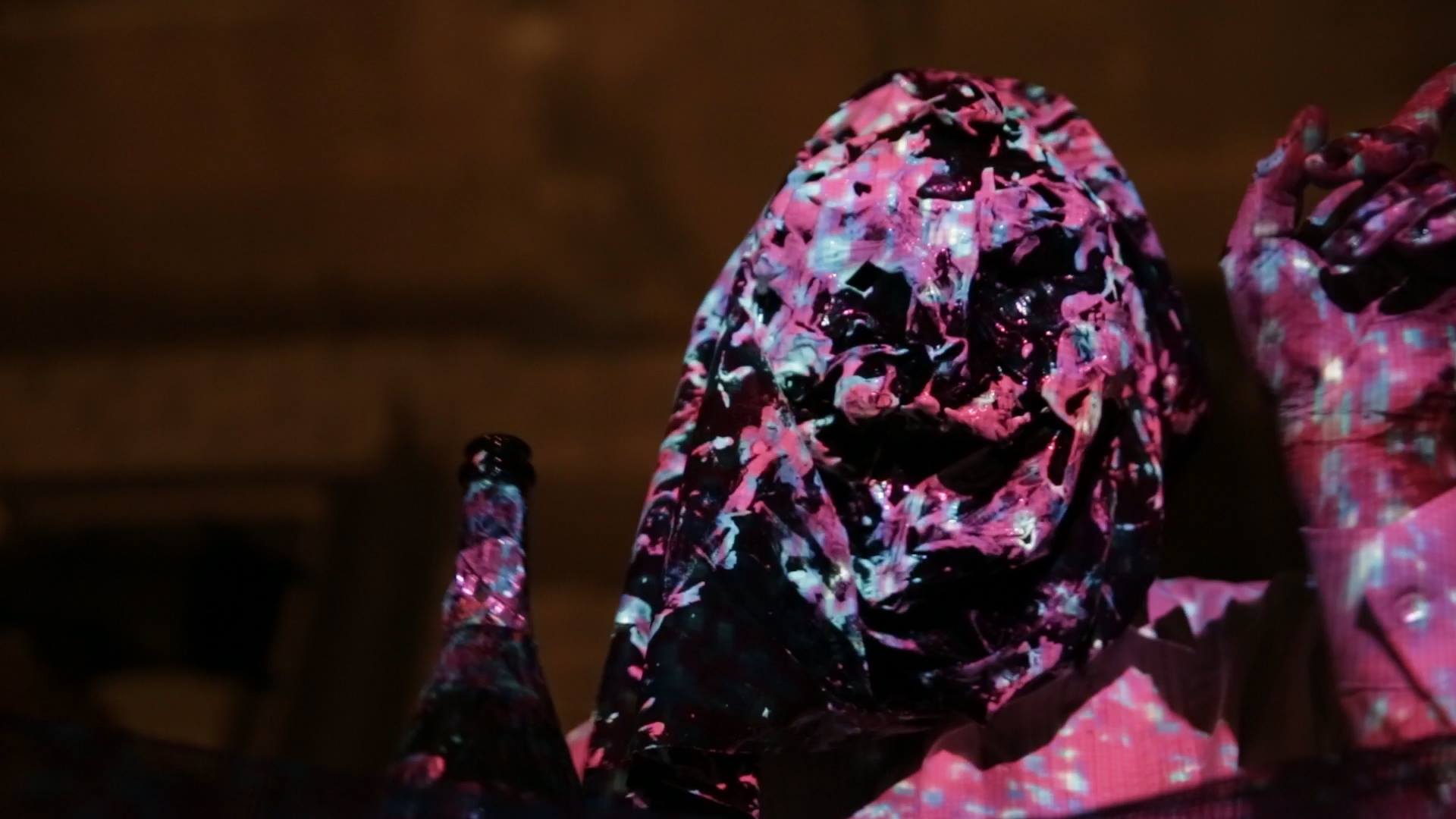
That’s when things get really good.
So even if you don’t always look at the work in that way, because it seems to have been created in that moment and not constructed, or at least not as strongly, a lot of work has gone into it. So thoughts and exchange. It’s not just a spontaneous idea. A lot of work has also happened before.

It’s not so easy to describe something that is supposed to be very free at first, but then a strict red thread develops, because there is already a choreographic background. Yes, and then the question, how did it actually form? To put that into words with hindsight. You actually already have a crass concept that is there before, but it’s not about who does what when, but who can do what HOW. And that everyone should be himself or herself, but that the frame is then addressed or defined. It’s interesting how you find a common denominator in something like this, where everybody wants to find the denominator, but also everybody wants to bring in his individual thing. I’m just trying to imagine it like this: I come into the showroom. Because we had started with pictures. Everywhere are pictures from different artists. You then come out of the pictures towards the people. There is the sound, the tone, the projections and you come out of the pictures as walking art objects. You give the visitors a megaflash. A comprehensive sensory perception. Is that what you’re trying to do?
Yeah, we’ve heard that many times too. So that we seem like completely different planets. Like from a world from a completely different planet. That is also always the question in which context we then do this and how much freedom we then have. I already said earlier, our first performance, we thought we would make a program to accompany our first exhibition at the Diamond Exchange. But then we were suddenly asked. Can’t you perform with us?
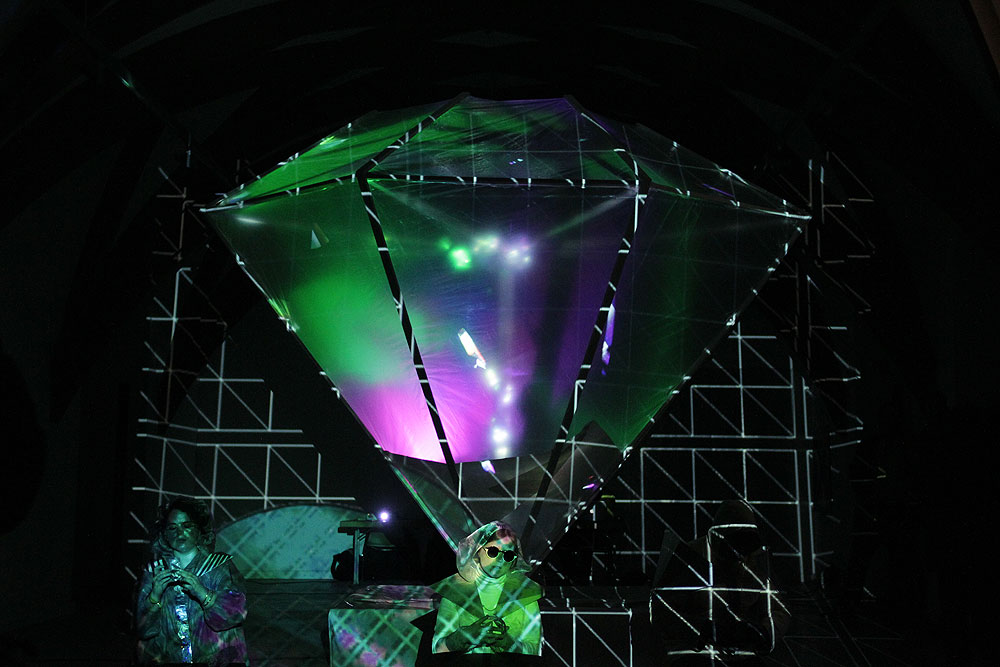
It was obviously well received by the public.
Yeah. But we didn’t really have that thought before. But then we somehow kept on doing it and we always have to be a bit aware of what the circumstances are. Of course it’s different if you suddenly find yourself in front of 400 or 500 people during the summer of art in Montez or if you perform in a small gallery room in front of 20 people. That’s a very different situation. You can feel the audience and then you also behave differently or make other movements or react differently. We’re very close to the people. There are already some parallels to the theatre through this stage situation, but nevertheless we are closer to the audience or more on the same level. Although there are never any chairs, interestingly enough, people always keep the border to the stage set. It has never happened before – for whatever reason – that anyone is going to whiz through or come very close to the stage.
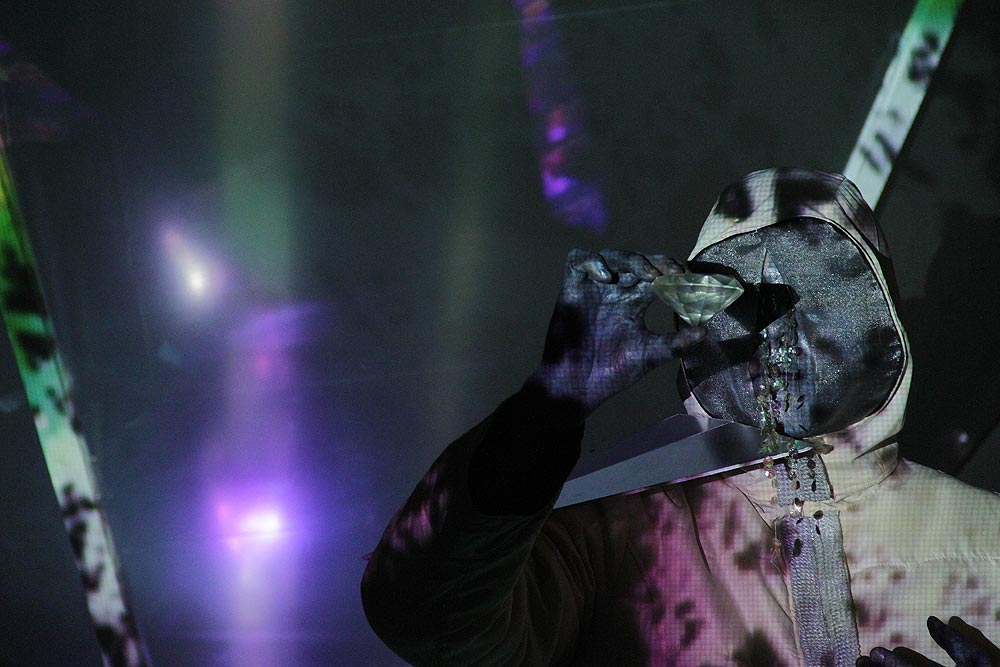
But you would almost wish for that? Or you’ll find out something like that. Because the audience wouldn’t have to. You also challenge. According to the motto, get up, let’s break up this typical in front of the TV. And I’m gonna get out of the picture, out of the TV. And I pull the visitor from his couch into the picture.
Sometimes it happens after a performance or after a break and when the shock subsides. So that is also the shock sometimes for the audience. We don’t always get applause. It can happen that someone goes on stage and does a few selfies. That’s perfectly okay. Or they want to take pictures with us. Of course we do that too. But in the meantime, no. There’s always that line. But such an imaginary one. Never one we pulled. It’s one that the Visitors have drawn. Maybe it’s also because we work with light in this way.
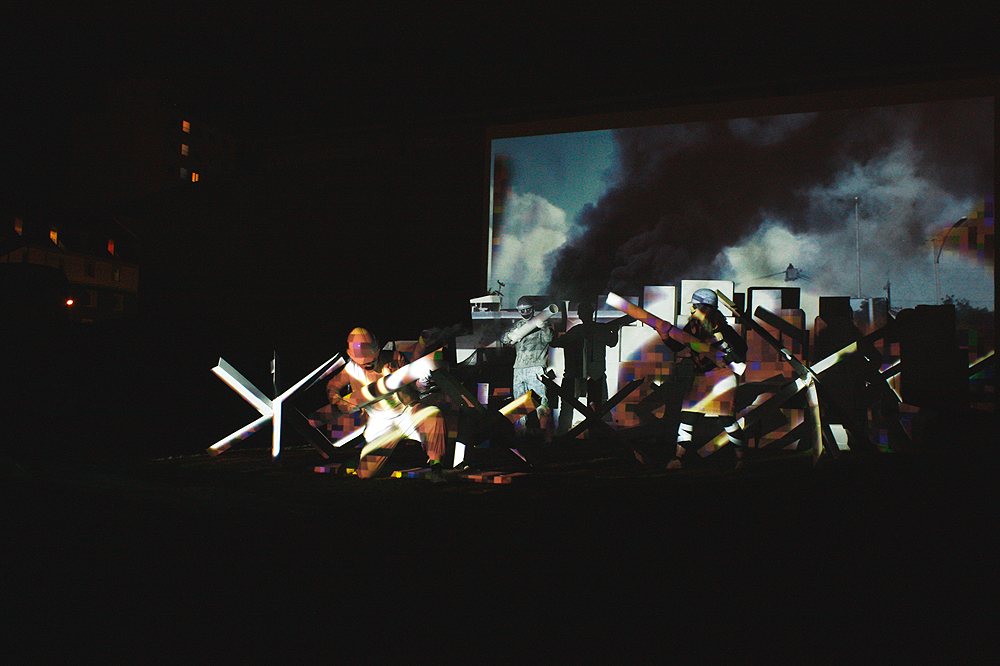
Why don’t you just run into the audience? Have you done this before?
We’ve actually done that. We also came in before the audience or through the audience or went into the audience afterwards. We also had a huge picnic in the lane at the night of the museums and the show was based on a Monet picture. That was then a huge orgy up to the border and until we really couldn’t go on. There we also gave the remaining food to the audience.
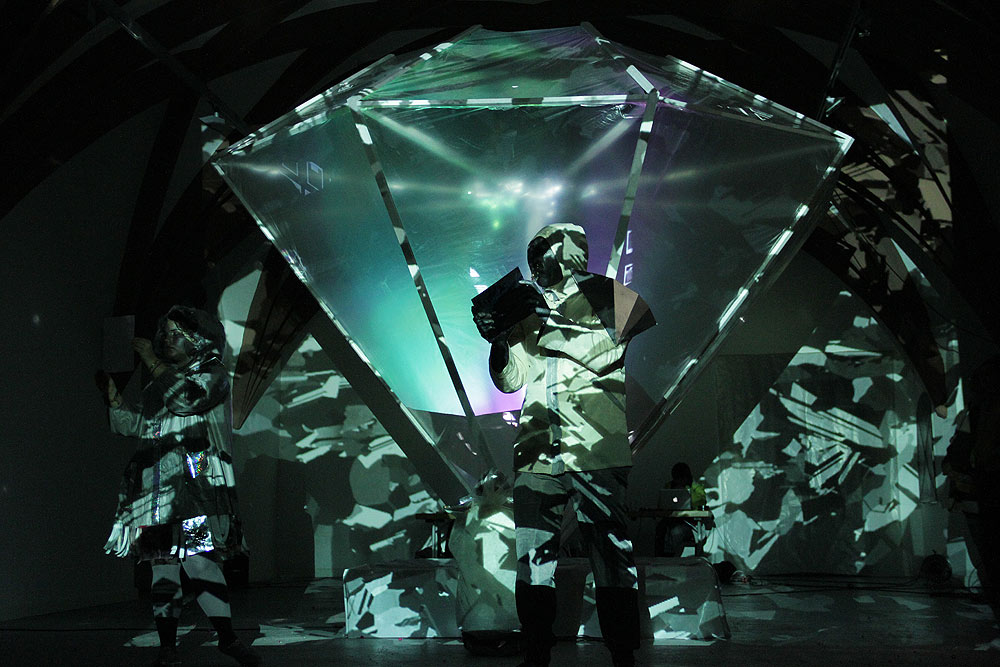
So it was like a feeding frenzy and you were playing the big game.
Yeah, right. And the people took it very politely and sometimes even tried it. But there was still such a gap. Maybe because we’re clearly breaking out. Because we wear elaborate costumes and masks and obviously fall out.
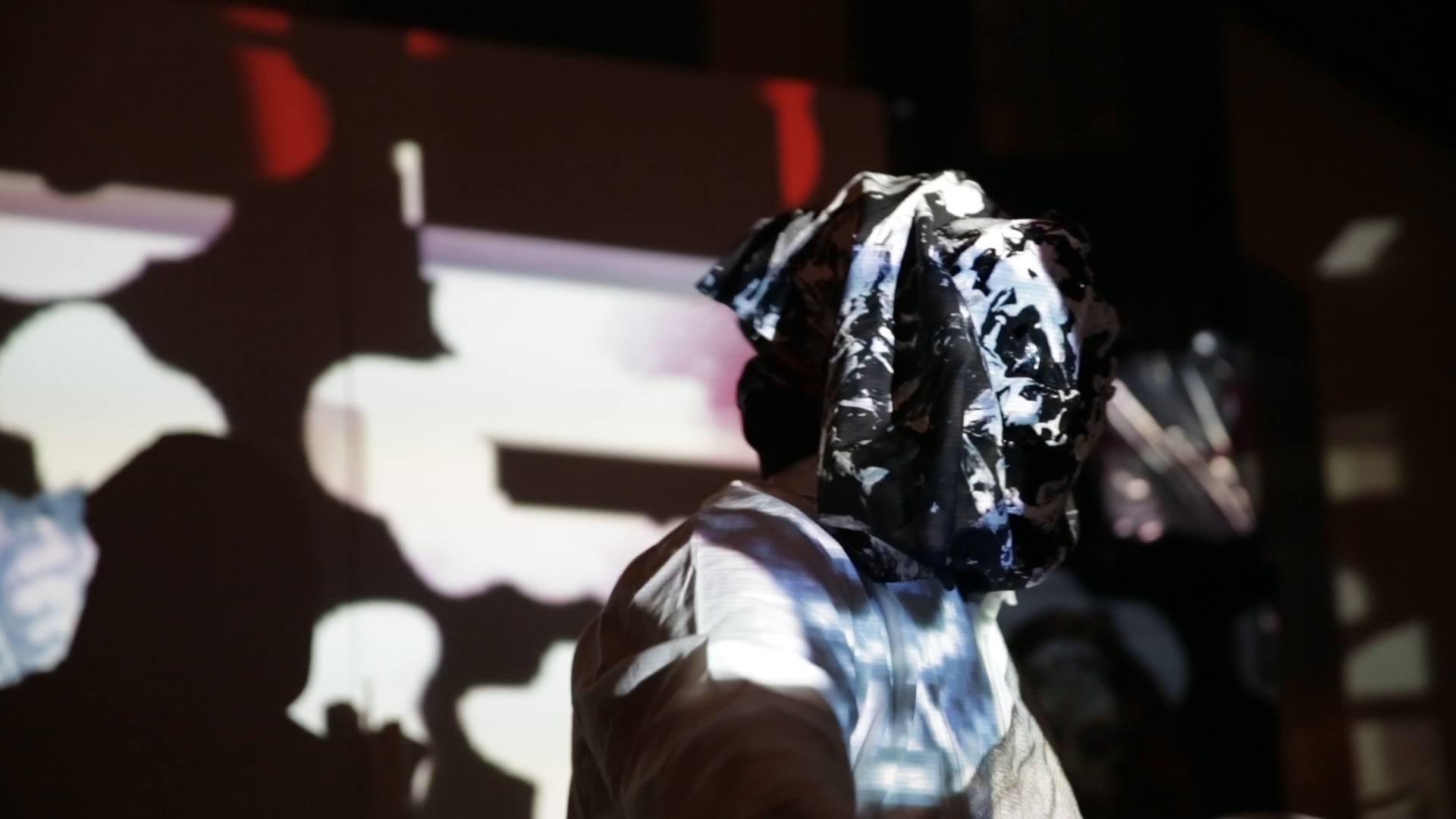
You work a lot with children. What’s it like with a kids audience? Do they keep that distance too?
No, they are super curious and want to know everything. And they are also very searching and interested in research and want to try out. Especially in puberty one is also very much in the finding phase and asks oneself the question, who do I want to be and where do I want to go and where do I come from. All these questions play a role, which for us artists might also play a role.
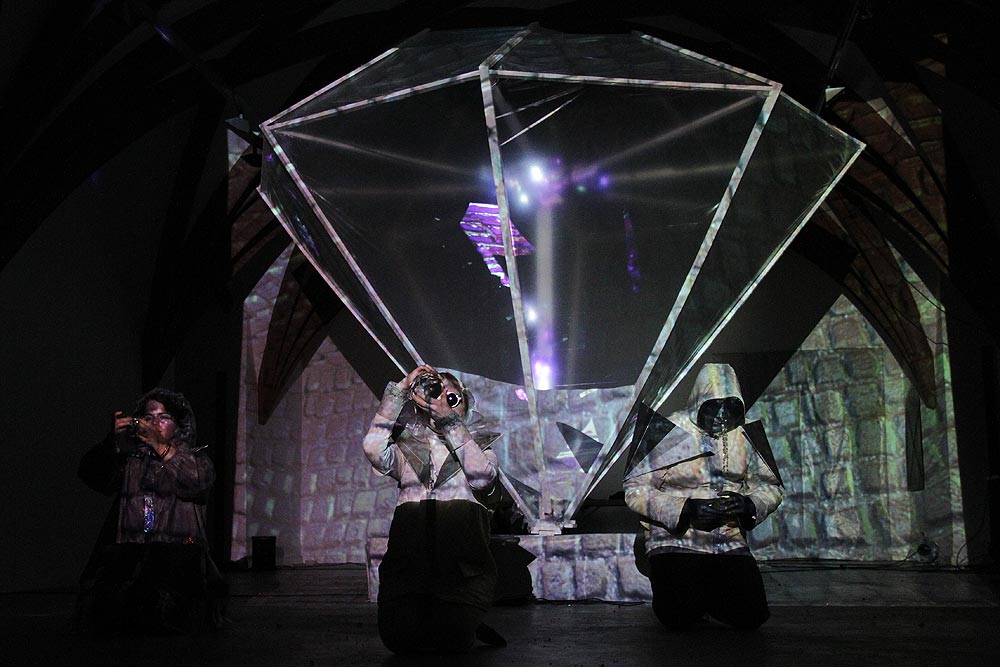
I think you are so good at youth work because you pick up the children exactly where they are supposed to be. Namely on the emotional level and that you don’t come up with something like memorizing. You feel them too and they feel that too and that is the way it should be at that age.
Yes, and I am really firmly convinced that art can be more than a luxury good for a few.
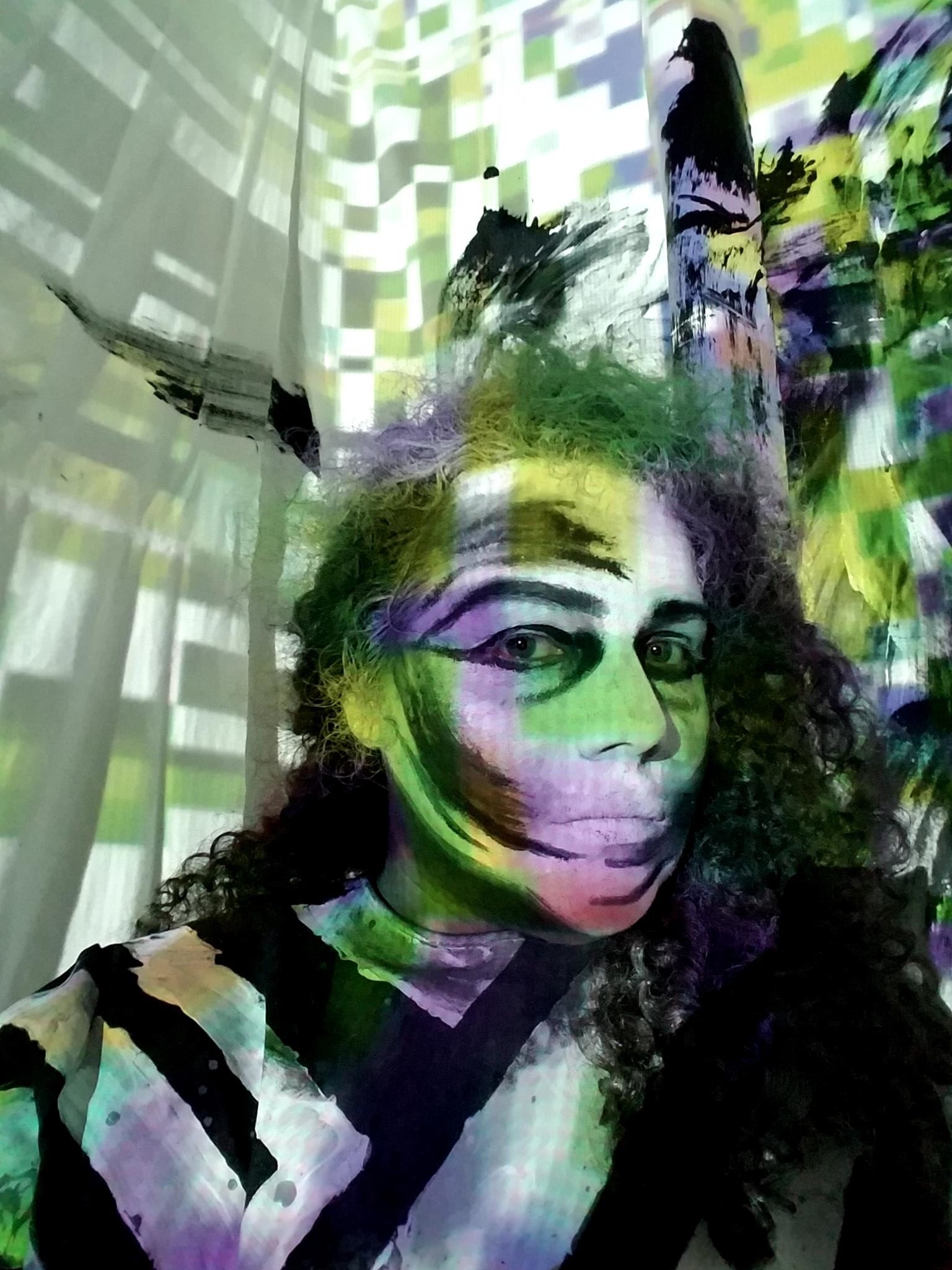
Exactly, because it can be the same at a higher age up to no matter how old, only you forget it a little bit. That’s why it’s extremely good what you’re doing. It’s not that an adult should be a child again, but some things are simply forgotten that are still there and you spill them to yourself in your head with all the constraints, regulations or whatever. But it’s there with everyone.
Yes, and it stays there. I think sometimes it has something to do with education, that you have certain codes of conduct within which you can behave as an adult. Or it’s uncertainty or something. You notice this for example when you go to the museum. I also do a lot of picture conversations and exhibition talks with children and young people, but also with adults.
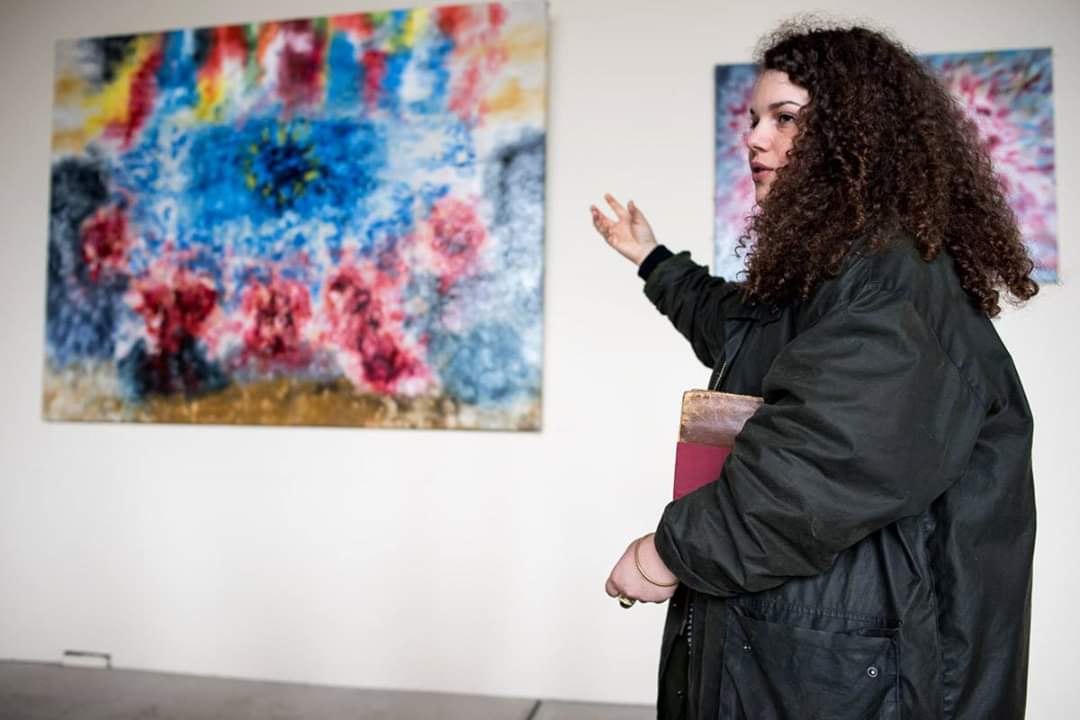
Could this be called museum education?
I’m doing that with the art society. This is an association and they work according to a certain method. So not in the sense of taking a tour, but actually I’m only there to moderate and let conversations happen. It’s not that I now explain to the viewers what they see, but that you describe yourself what is in front of you. And one really consciously looks at a work for an hour and then gets to know this artist or this work in a very intensive way. In comparison with adults, I have often noticed that adults of course often shine with their knowledge, with their expertise, or they have already read something and already dealt with the artist and then have a very clear idea. But often there is a certain hurdle to really get involved in this one job. There is such a defence mechanism and perhaps also a certain protection. In this temple of art, it is very rare that an adult dares to say that I don’t like the picture at all or that I can’t do anything with it.
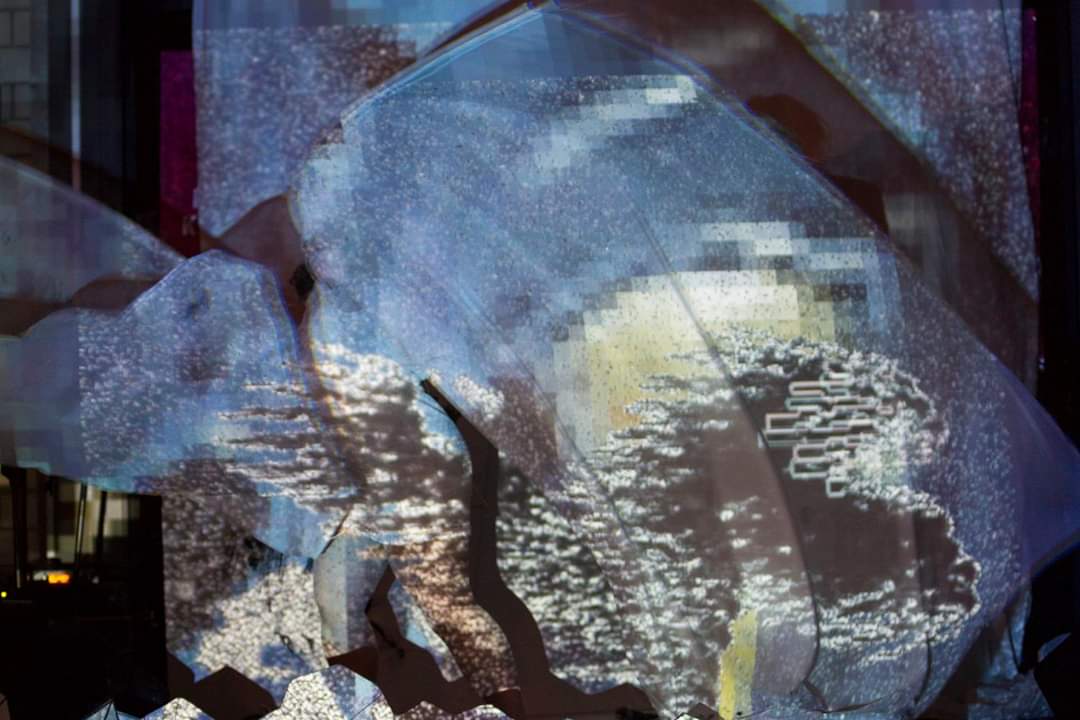
There’s this urge, so now you have to see something in it.
Yeah, right. Or you have to be able to interpret it somehow and otherwise you would have a gap in your knowledge. And with the children this inhibition is simply not there at all. They see that and then they just say that they think it’s really ugly. Then there are always these museum guards who of course look very piqued. Now how can you say that! This is now something from Nolde or Monet and this is super valuable and this is hanging in a museum and has its right to exist. Now this kid says he’s ugly, and we let him say it. But it’s not a question of if it’s ugly now. The much more interesting question is, why is it ugly? Why do you feel this way and try to articulate what your feeling is about it. And then it gets interesting. Then it starts to get really interesting.
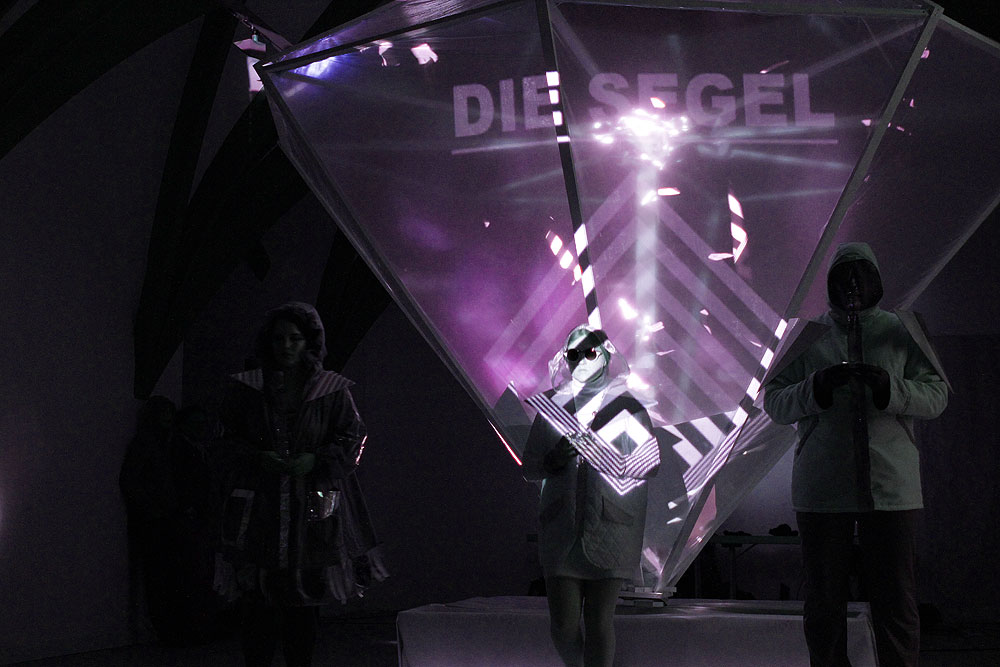
It’s not a question of whether this is good or bad or expensive, but what effect it has on you.
Yeah. And what is the real meaning. If you really deal with it and ask yourself why is it ugly now or why is it pretty or what is it about the work that maybe provokes me. There is such a thing. So works of art that not only don’t please you, but you almost feel insulted. And what exactly is it that triggers this in me? And then you get to the content and the real meaning.
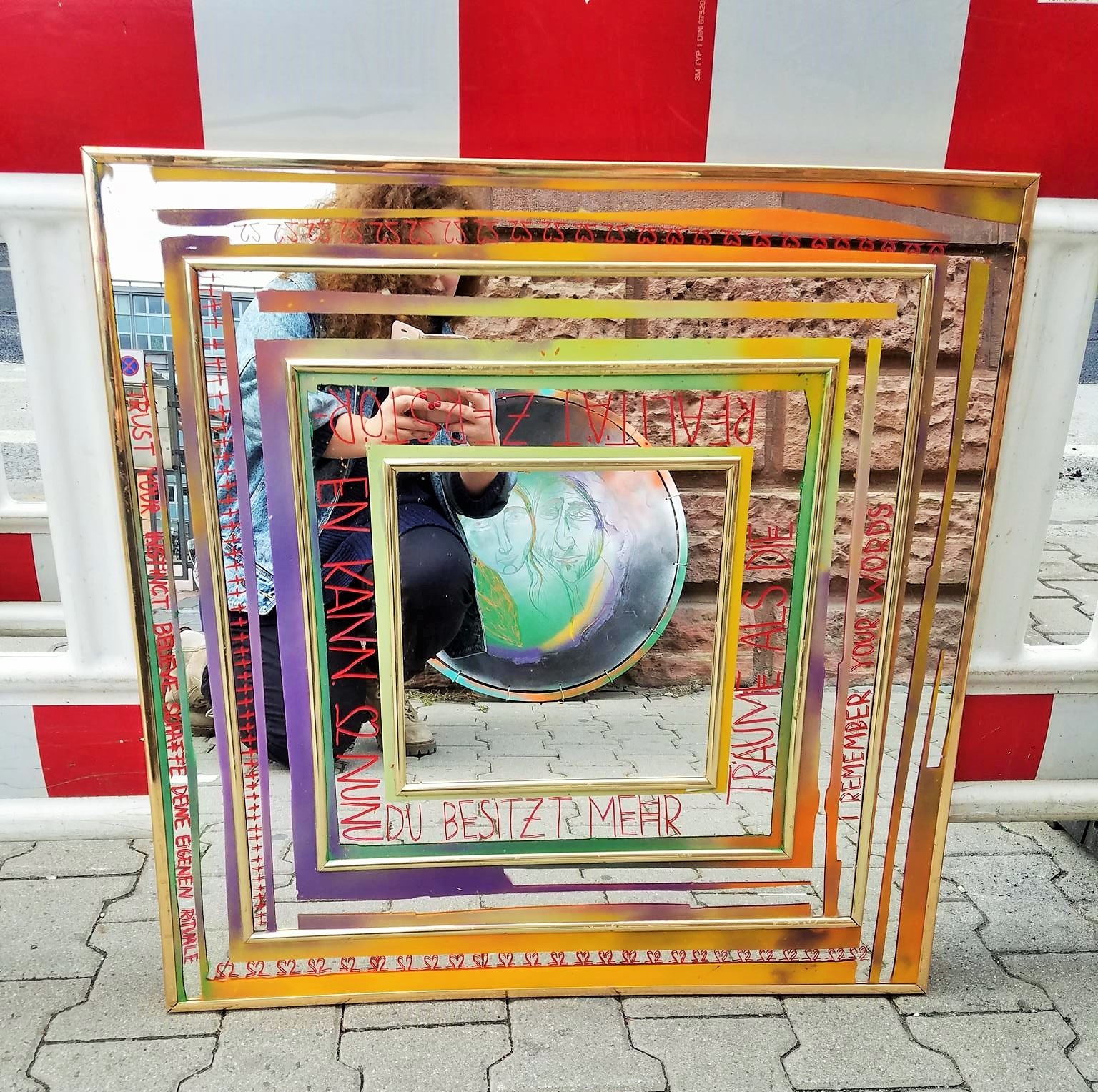
It is also about perceiving the world with more feeling. Some people might say I think the painting is ugly. I don’t like it, I don’t want to see it again. But another possibility is also to say that the picture triggers in me the feeling that I find it ugly. But I go even further into this and it has become one of the most important pictures for me, because I realized that this picture reminds me of the death of my great-grandmother. And suddenly it’s a favorite. It’s all about what action and reaction art can trigger, not how expensive it can be sold.
Yeah, you just said something about that. I think maybe in such a picture there is not only the loss of the one grandma, maybe the loss itself is also in this work or death itself. And that is why many people may feel something similar. Then you suddenly describe the meaning that this picture may have. Once you’ve unravelled that for yourself and realized it for yourself. So not by an expert, who now tells you what you see. I have also often noticed that when you talk to adults, children and young people are much quicker to grasp what they see and are not so prejudiced. They also dare to say very quickly, no, I do not like it or I do not like it. They are more honest and direct, not so inhibited either. And this question, i. e. when you have unravelled it for yourself and have found out what it is exactly, very often the perception of an image changes in the end. When I have recognized what is in the work, what makes me so upset or what I find simply horrible, then suddenly the way in which one sees and perceives the picture changes. I have experienced it quite often that someone then suddenly finds the picture really good. Or finds a video work really good.
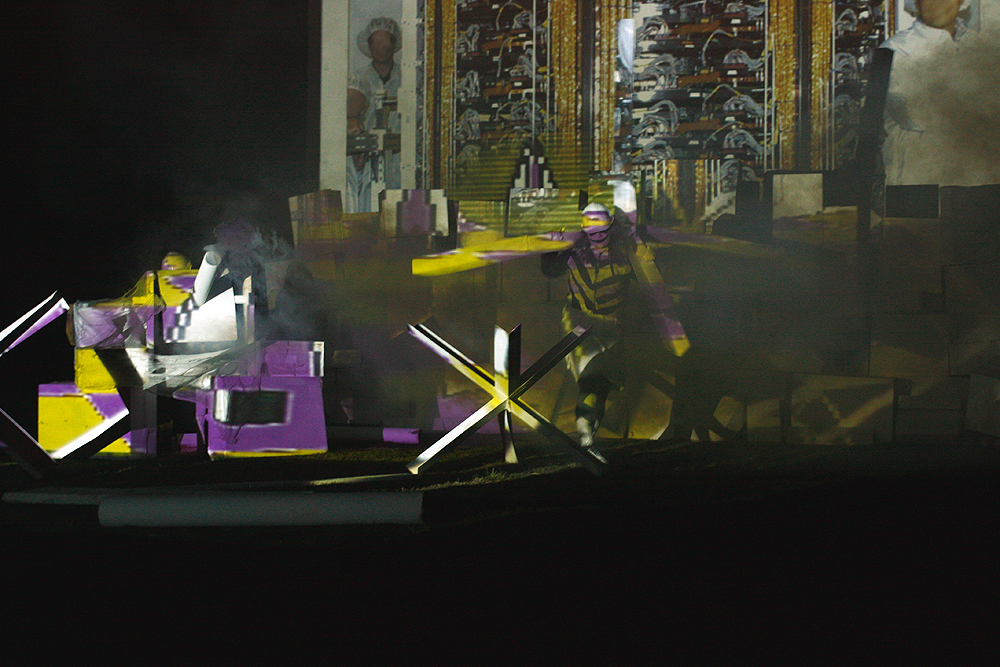
It can also be like a kind of psychotherapy through an image. The picture can open a window to the emotional world and you can ask yourself why I have this reaction to the picture. It is perhaps also an easier way to get rid of painful and also negative feelings. To find access to simple and positive feelings is always quite easy, but to the not so pleasant ones it is more difficult.
We had this already, that after one of our performances the audience found the whole thing disturbing. But I think that art is not always about the beautiful flower meadows. Especially in times of upheaval, you can see in art again and again that the images of the artists also change. Immediately before wars one has already seen something like a premonition in the works. And I think it’s important to deal with that too. That you don’t just follow the beautiful pictures on Instagram all the time and everyone is happy and you just end up with nothing. Because it is so unsatisfying and you are always running after these Likes and yet you are actually looking for love and recognition. Art can really give you more than just some pretty thing you hang up or the big name you bought and collect. Art can really deal with things. But that also means that it is exhausting for the viewer. Definitely. That demands a lot, but especially nowadays you have to deal with such things. You can’t just say no. I also don’t know if you can speak of good art if it is polite. One cannot want to please at all costs. After all, that is not the task of art. At least not the good art. The art that wants to please may just sell better.
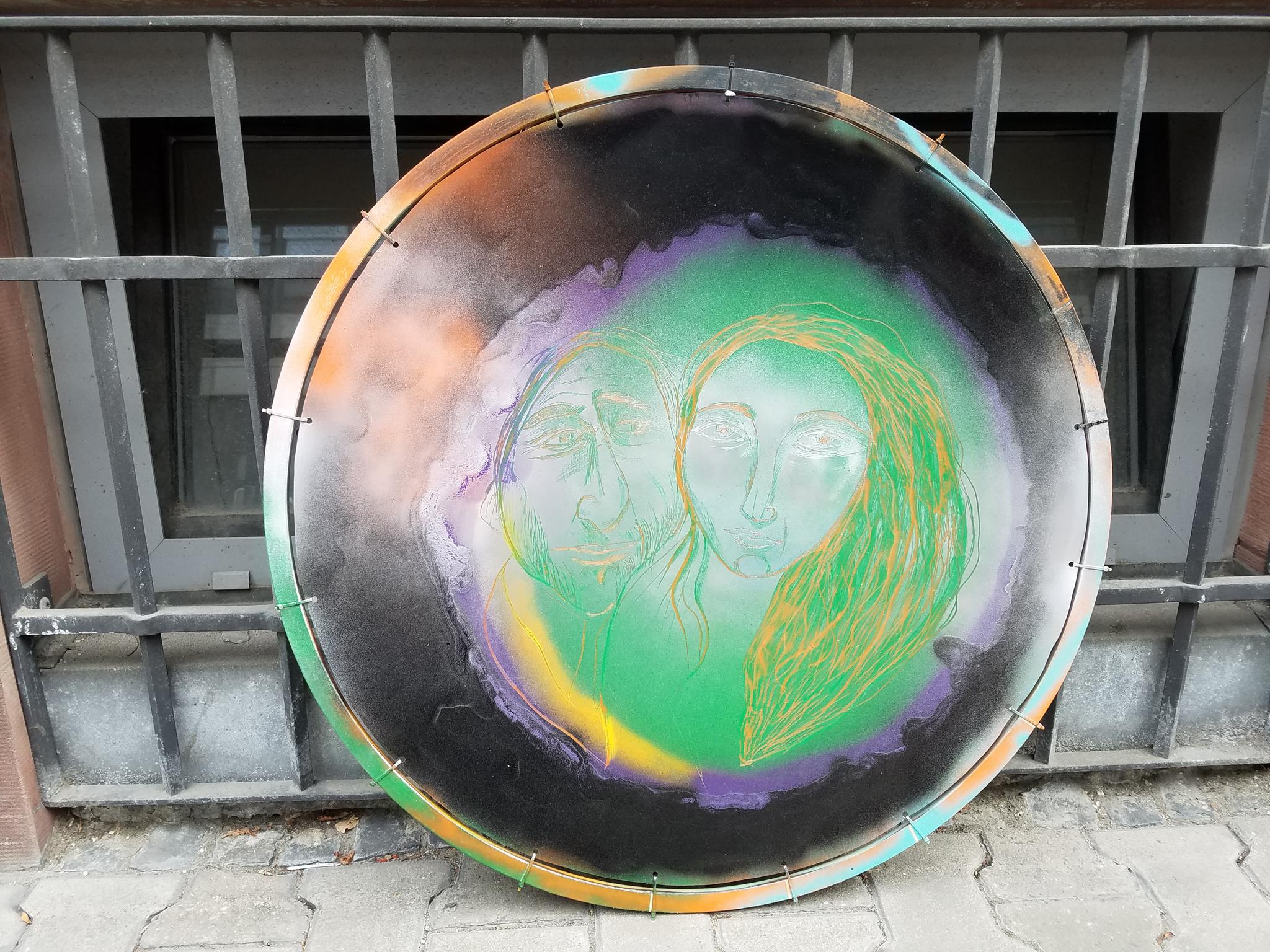
That’s why art can be anything. One cannot determine that art must always make someone feel good.
Yeah, then it would be decoration or kitsch. Although sometimes I like kitsch. But we live in a flood of images. We are bombarded daily with images and probably you have this defence against images that may disturb you or perhaps even frighten you. Then you have such a defence mechanism and you can’t get involved in it because we are simply bombarded with pictures every day. But I think, especially today, art should not, or artists should not be made into tools to feed these machines with images. I mean, inordinately. Above all, you are then very quickly on a completely different level. One should really also stop for a moment and get involved with a work or a picture and also take the time to really deal with it. That I am much more sustainable and fertilizing and satisfying and real soul food than this fast moving. But we are also part of it ourselves.

That was a nice word just now. Art must be soul food. It must be touching me. It should have more of a claim to touch people than just want to sell itself.
We’re in for some pretty practiced perceptions ourselves. Well, I can’t speak for the others on Die Segel. There’s also Dirk Baumanns, who also does performances, and Maximilian Reimann, who documents with film and also makes great documentaries or short films, which are then naturally their own work. You really have to say that, because he also makes a lot of decisions during editing and that is then again an independent work. Sven Schuppar always does the graphics and has also designed our logo. We fertilize each other all the time, rub against each other, argue and discuss. I also have to say that I really learned a lot from Die Segel, from the guys and from this intensive time we had together, and I grew in it, I became more self-confident and also more secure with my own value judgement and with my own artistic identity. And also what I define for myself, what art is or what the commission for art should actually be. This is also sometimes a painful process and one also experiences precipitation. It’s simply a matter of failure. You have to be very clear about that. Of course I didn’t choose to fail in moments, but it was always a very painful experience and I have experienced it a few times in my life. But of course, every crisis also holds the possibility of questioning oneself again and perhaps redefining and re-examining oneself. If everything goes well and everything is successful, then there is no need. But that is also part of it, we are human beings and not robots and we also make mistakes. If you come from painting, then you also know that a picture is created in layers. There are certainly geniuses who make the masterpiece at the first go, but it is usually a long process. There were also pictures that I painted in one piece in one night and then I was finished. But there are also some that take months to paint. And there you have to start over and over again and paint over again. That’s painful too. It’s the same in life. Death and illness are part of it and failure is also part of it. If one defines oneself as an artist, then it is already a high degree to say that I want to bring my life, my experiences and also my failure into my art. That is of course also a risk. That’s when you make yourself vulnerable. It is easier to paint beautiful pictures than uncomfortable ones, but I think it is worth it in the end.
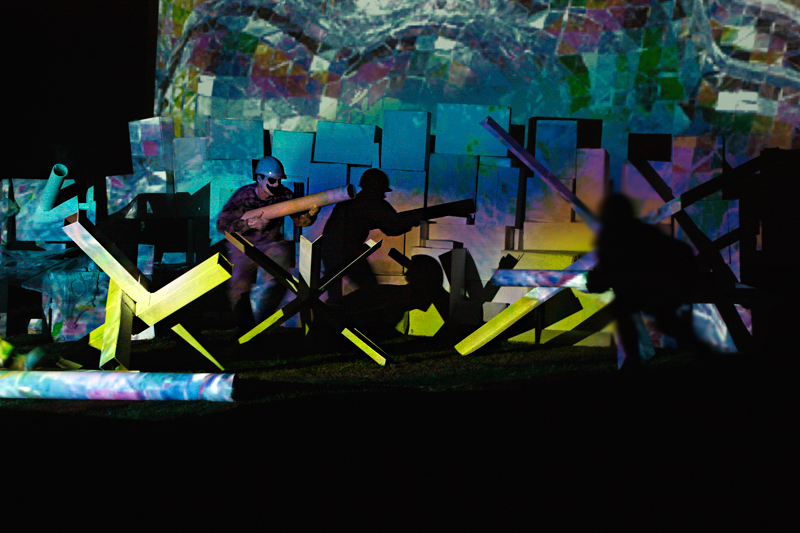
“Die Segel” about themselves on their website:
“Die Segel“ is the connection of artists, of media and media entities. Each of the artists covers different media areas. Together “Die Segel“ create a conglomerate of themes and visual worlds. The goal is the joint product, which is presented in performances, film sequences with musical accompaniment and photographs. The performances are created in front of the audience. Using graphics programs and beamers, images are projected onto the acting performers and the image space. This happens in real time, just like the generated music, in the same way that it responds to the acting Segel in its own form and is created irrevocably in front of the audience for the first time. A fragile moment is thematized, whose premise presupposes the affirmation of the image. It is not necessarily the narrative strand that determines the dramaturgy of the performances, but the tension and composition of the individual images played. In dark environments, images are thrown out of the computer onto white surfaces. The goal is the human-corporeal reconquest of the technical-medially mediated image world. In reference to Maurice Merleau-Ponty’s quote on the field of painting: "By lending his body to the world, the painter transforms the world into painting. In order to understand these transformations, one has to rediscover the acting and present body, it, which is not a piece of space, a bundle of functions, but a thing that connects perception and movement.
INFOTHEK
![]() Artist: TAMARA ZIPPEL
Artist: TAMARA ZIPPEL
![]() Instagram: https://www.instagram.com/taratata_studio
Instagram: https://www.instagram.com/taratata_studio
![]() Performace: DIE SEGEL
Performace: DIE SEGEL
![]() Website: http://www.diesegel.de
Website: http://www.diesegel.de
![]() Facebook: https://www.facebook.com/diesegel
Facebook: https://www.facebook.com/diesegel
![]() Vimeo: https://vimeo.com/user6440940
Vimeo: https://vimeo.com/user6440940
![]() Art Society: KUNSTGESELLSCHAFT
Art Society: KUNSTGESELLSCHAFT
![]() Website: https://www.kunstgesellschaft.de
Website: https://www.kunstgesellschaft.de
![]() Youth Club: BREAK 14
Youth Club: BREAK 14
![]() Website: http://break14-frankfurt.de
Website: http://break14-frankfurt.de
![]() Facebook: https://www.facebook.com/Break14-177557852285939
Facebook: https://www.facebook.com/Break14-177557852285939
![]() Die Segel – Dirk Baumanns: http://www.dirkbaumanns.com/
Die Segel – Dirk Baumanns: http://www.dirkbaumanns.com/
![]() Die Segel – Daniel Eyrich: https://www.systemtheoretische-musik.com
Die Segel – Daniel Eyrich: https://www.systemtheoretische-musik.com
![]() Die Segel – Maximilian Reimann: http://www.ximilianreimann.de
Die Segel – Maximilian Reimann: http://www.ximilianreimann.de
![]() Article: Dirk Baumanns & Die Segel: https://vagabundler.com/performance/dirk-baumanns/
Article: Dirk Baumanns & Die Segel: https://vagabundler.com/performance/dirk-baumanns/
![]() Foto Credits: Die Segel, Stephanie Buschmann, Arndt-Tibor Koch, Sven Schuppar, Tamara Zippel
Foto Credits: Die Segel, Stephanie Buschmann, Arndt-Tibor Koch, Sven Schuppar, Tamara Zippel
